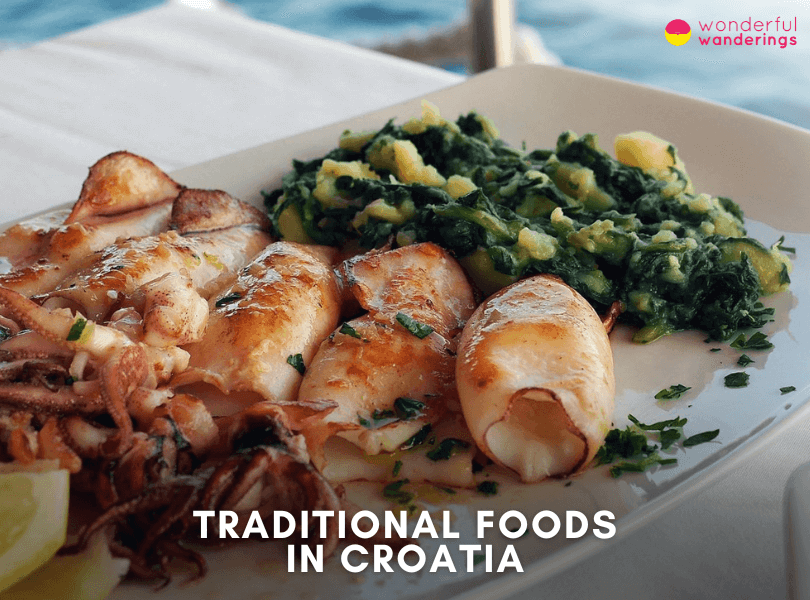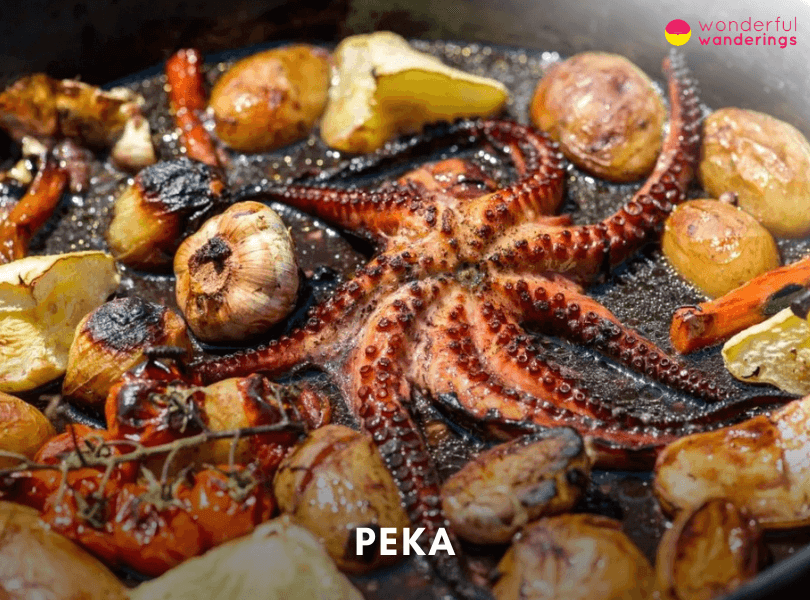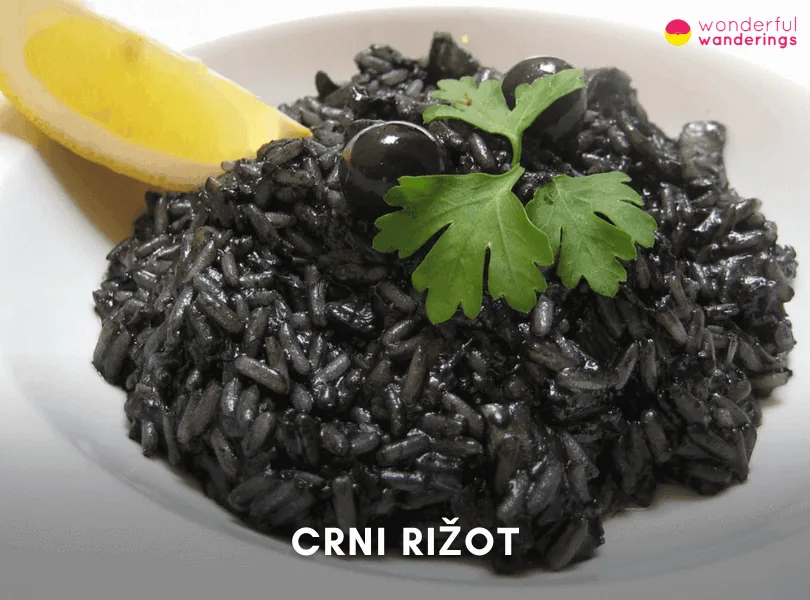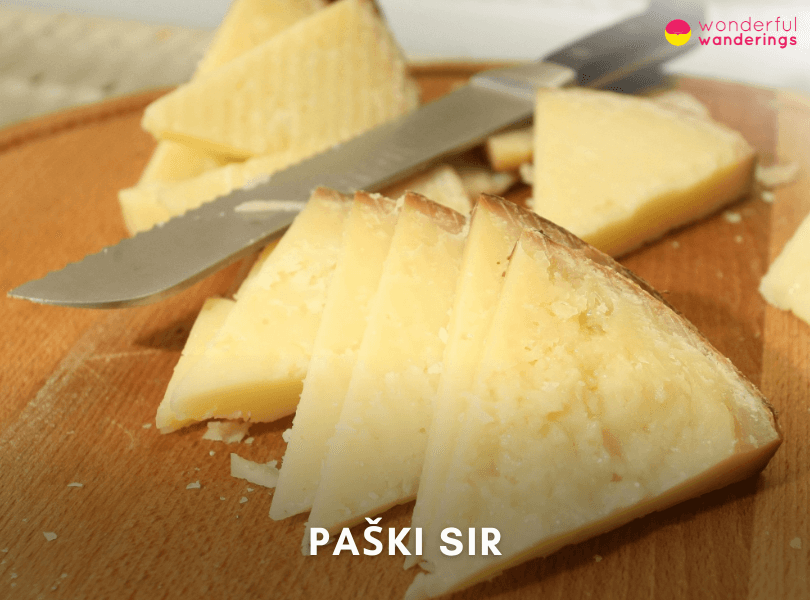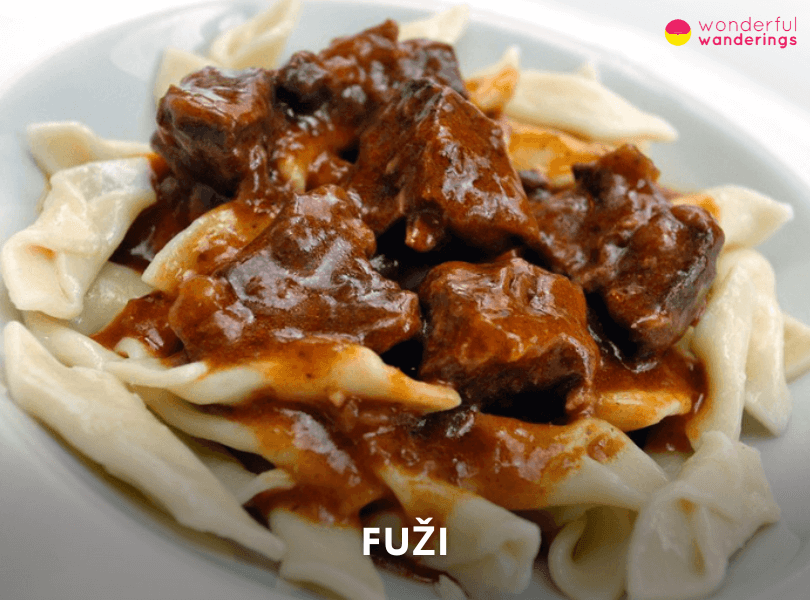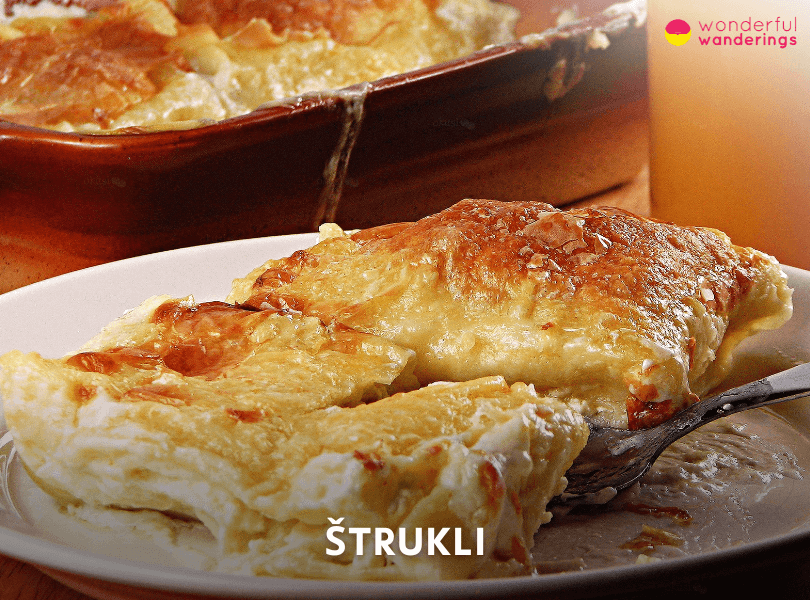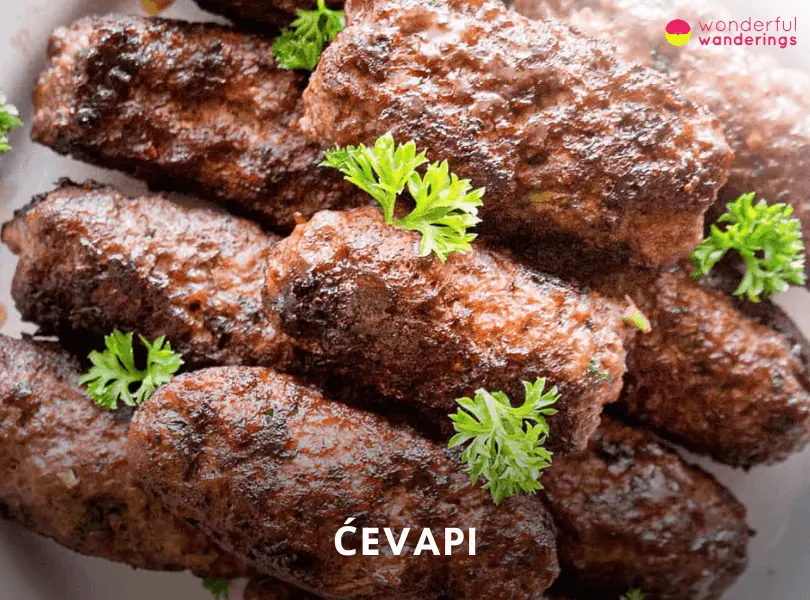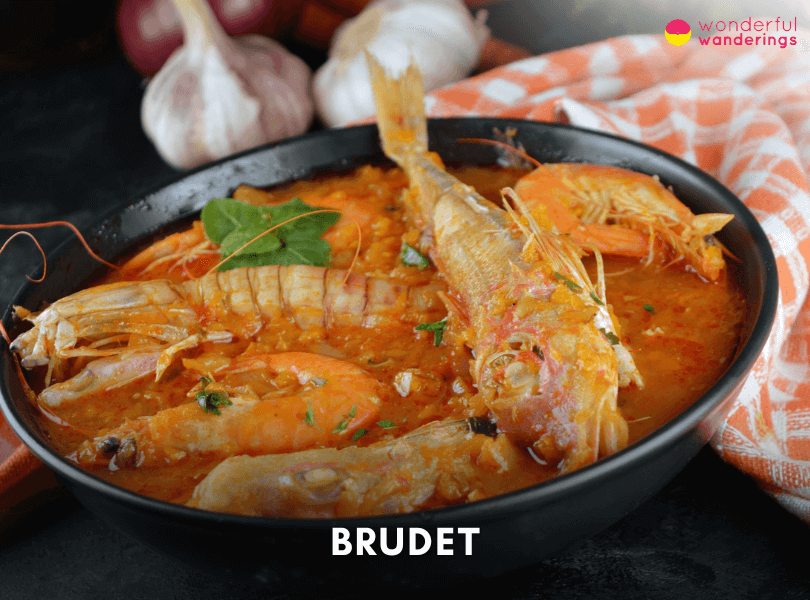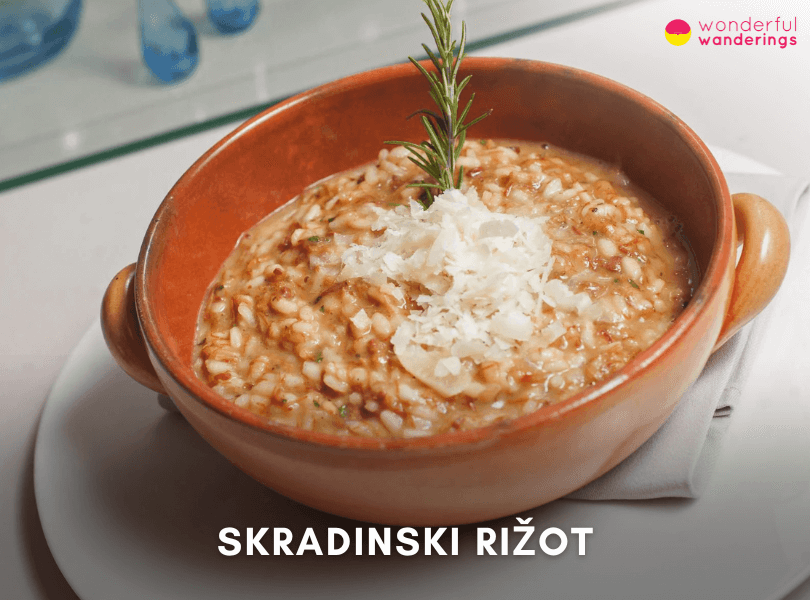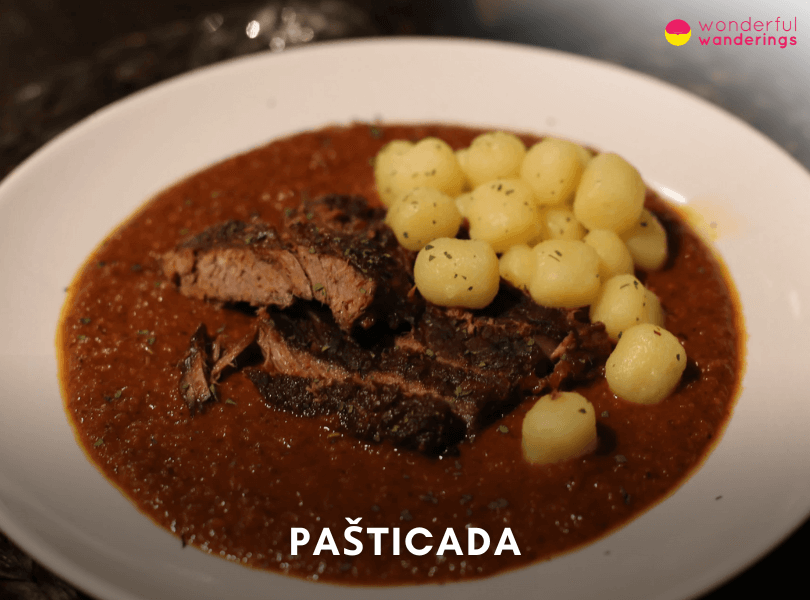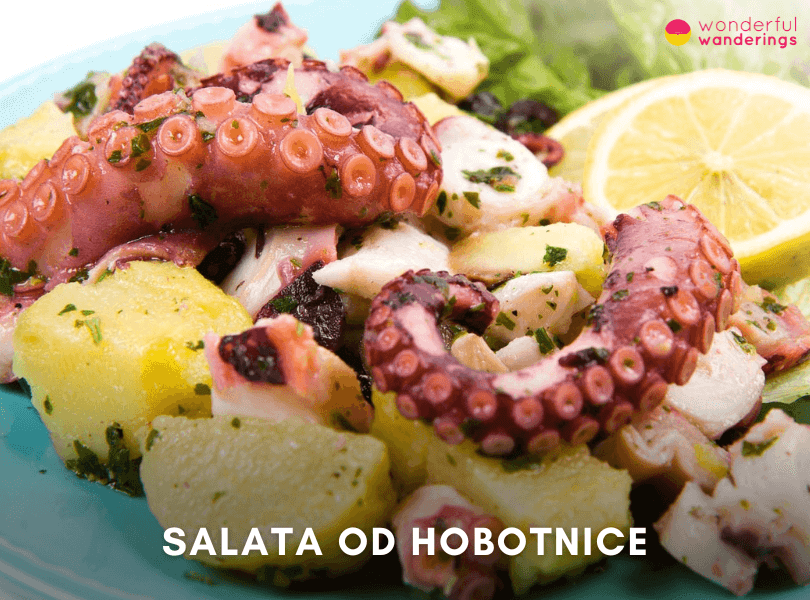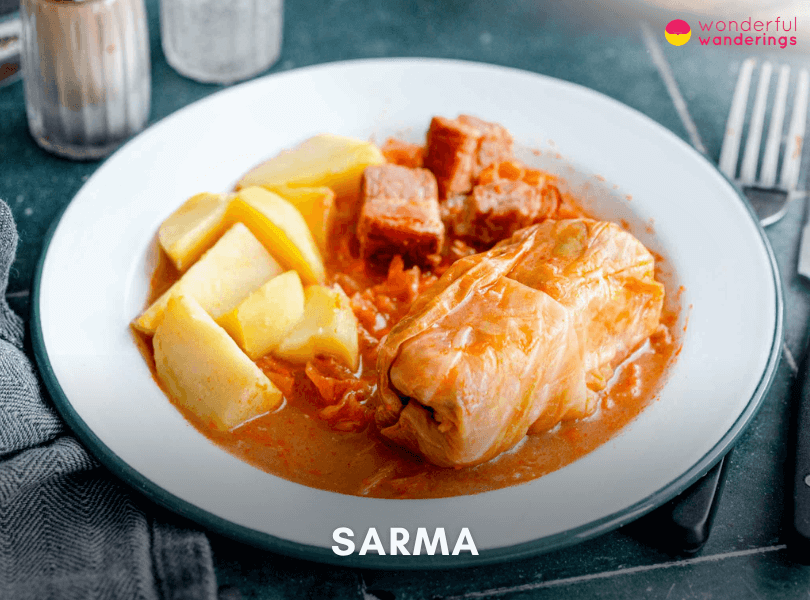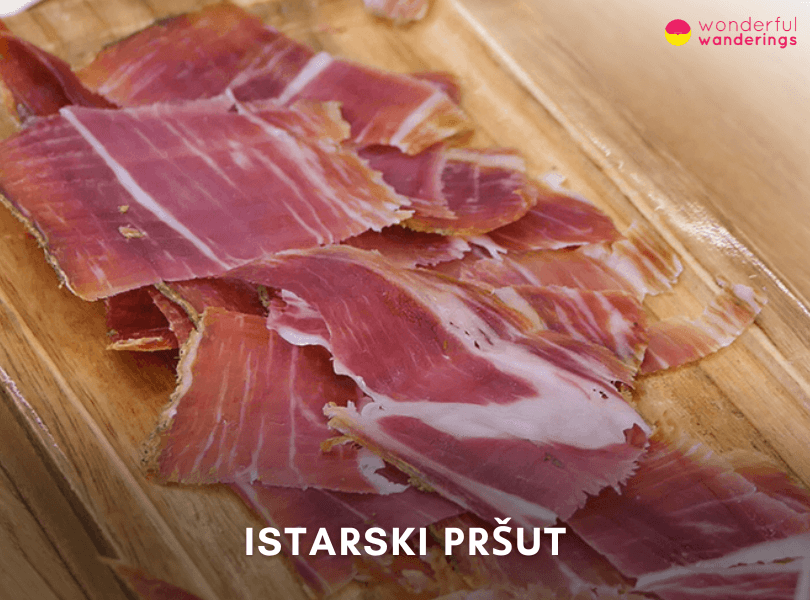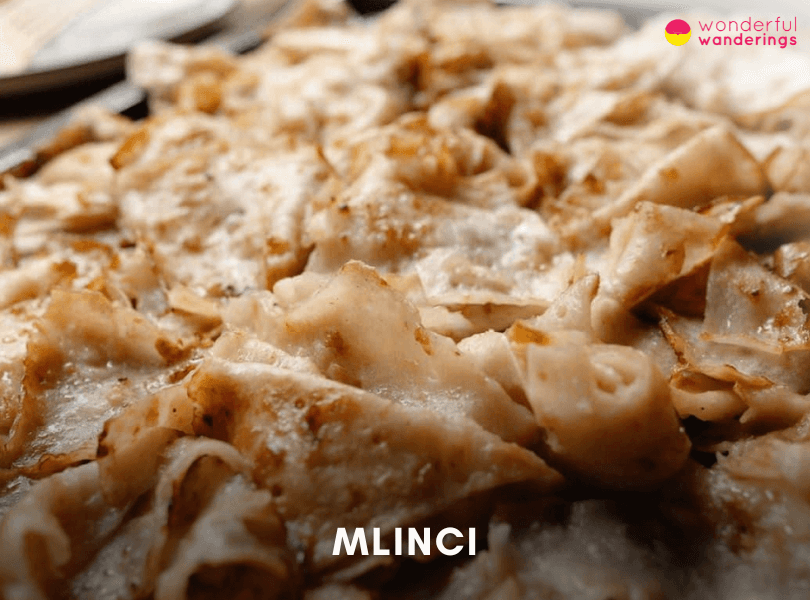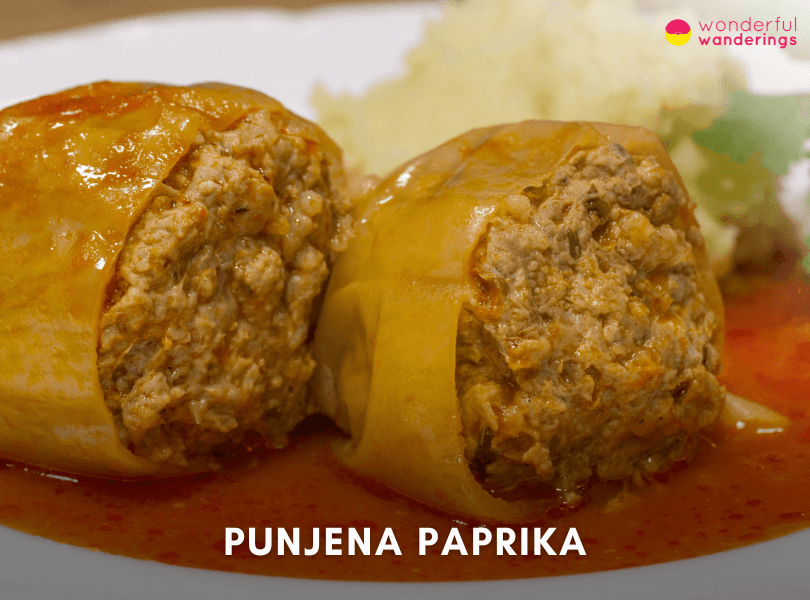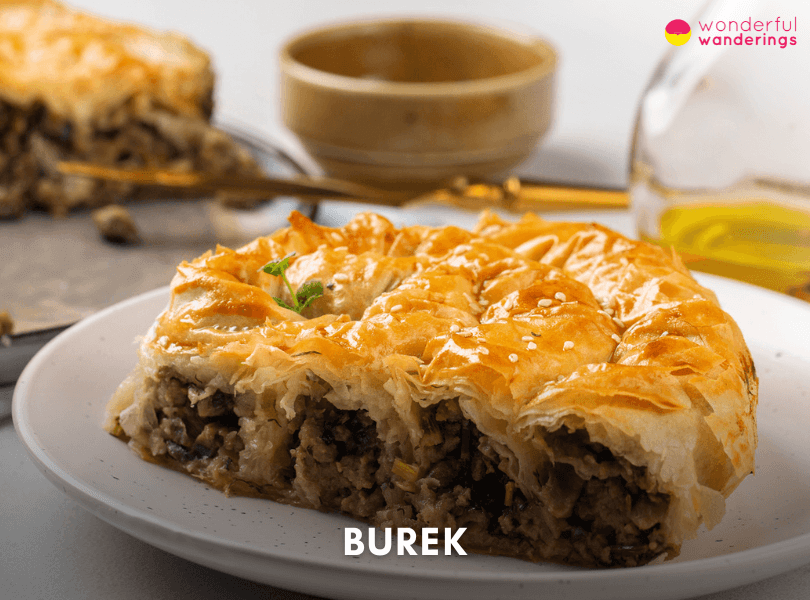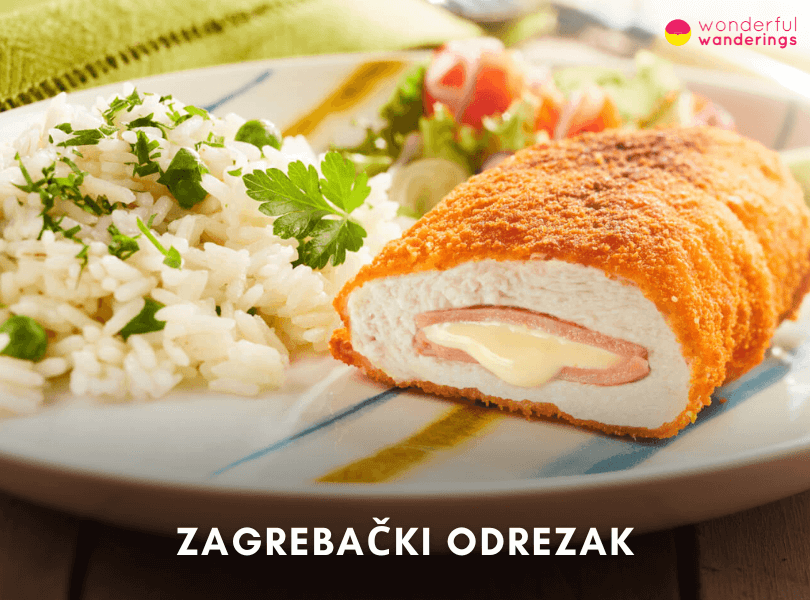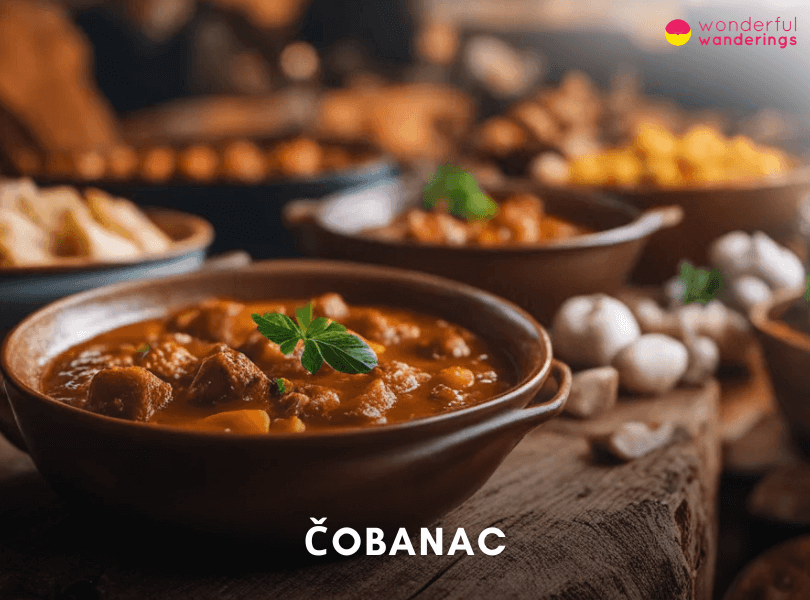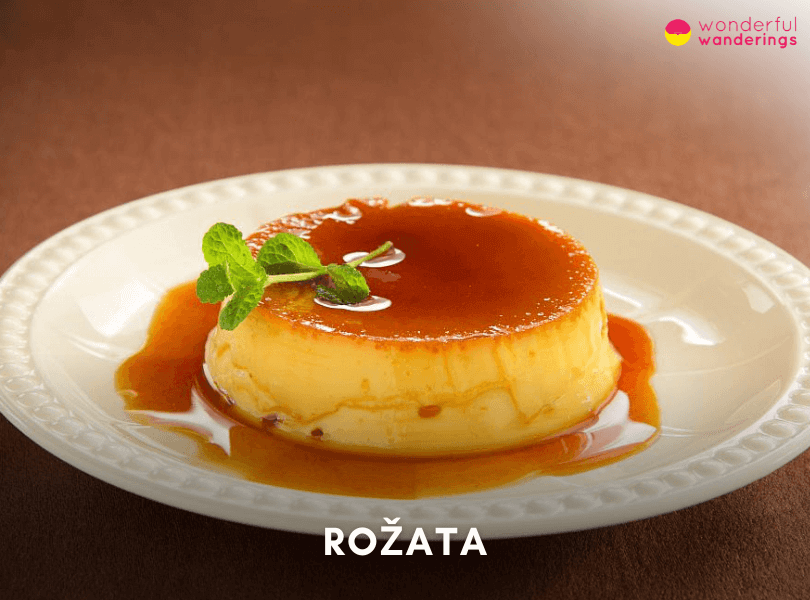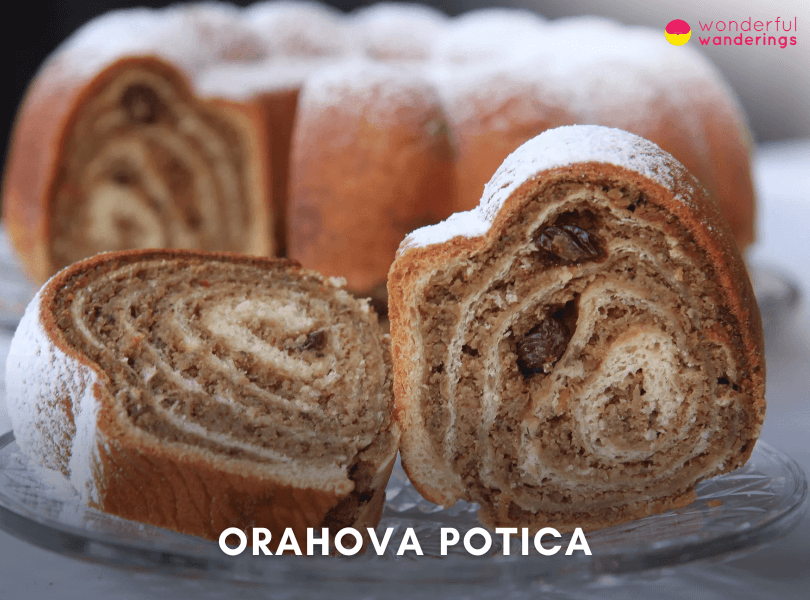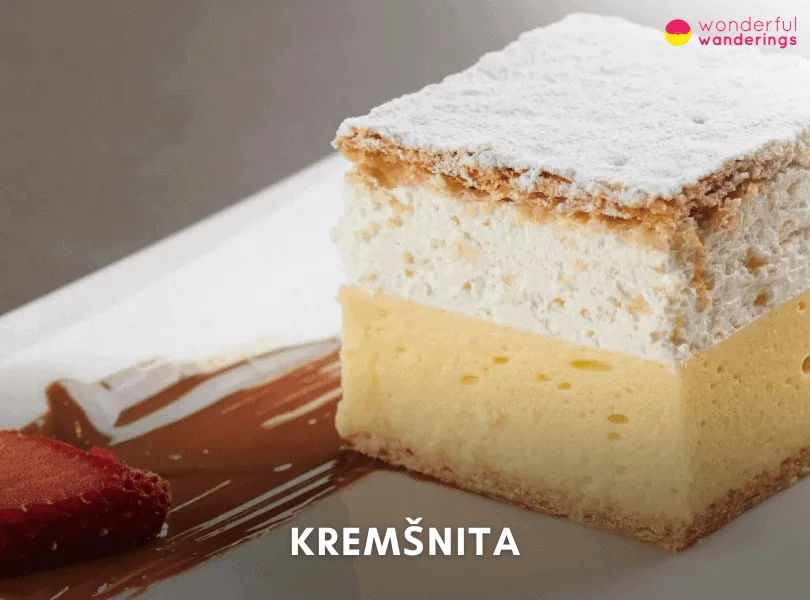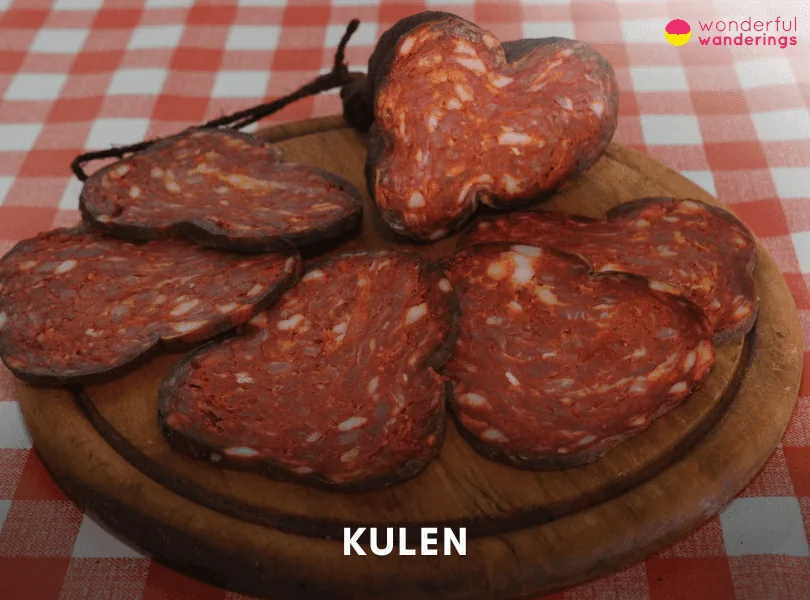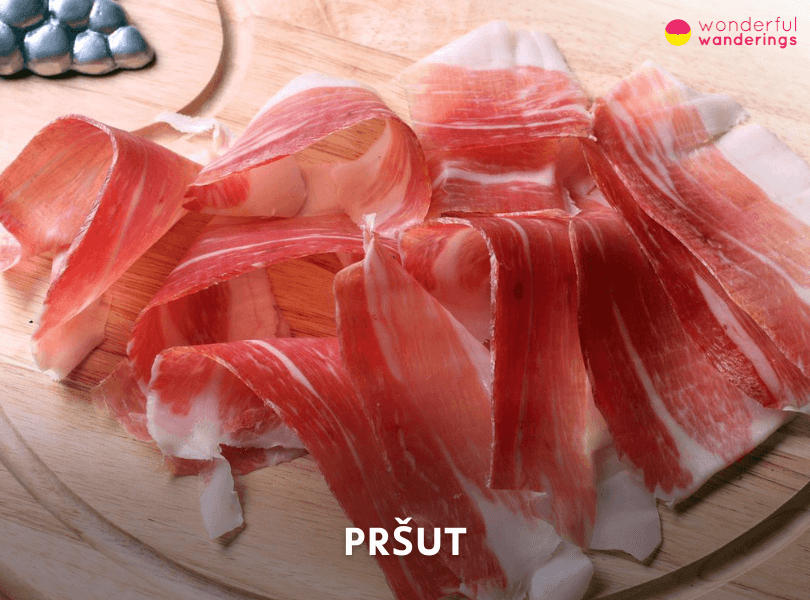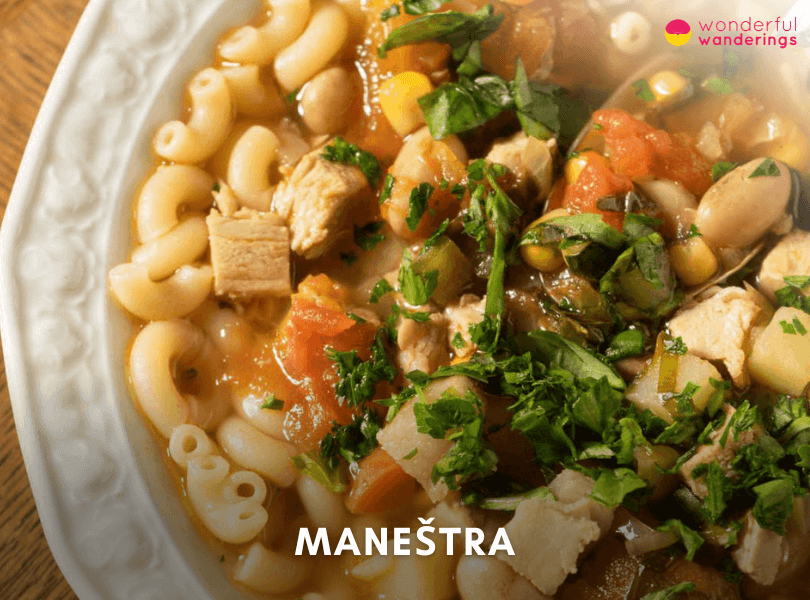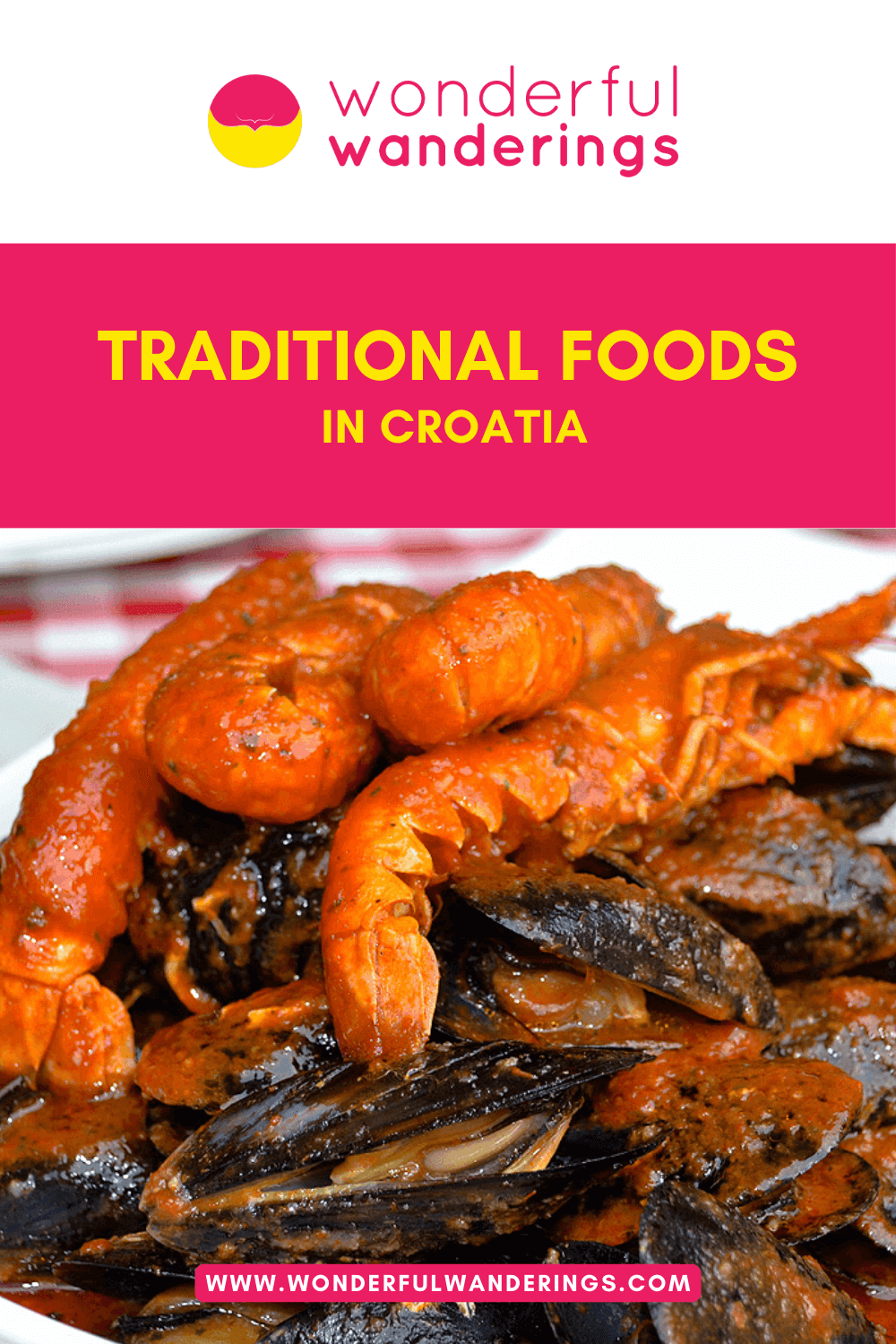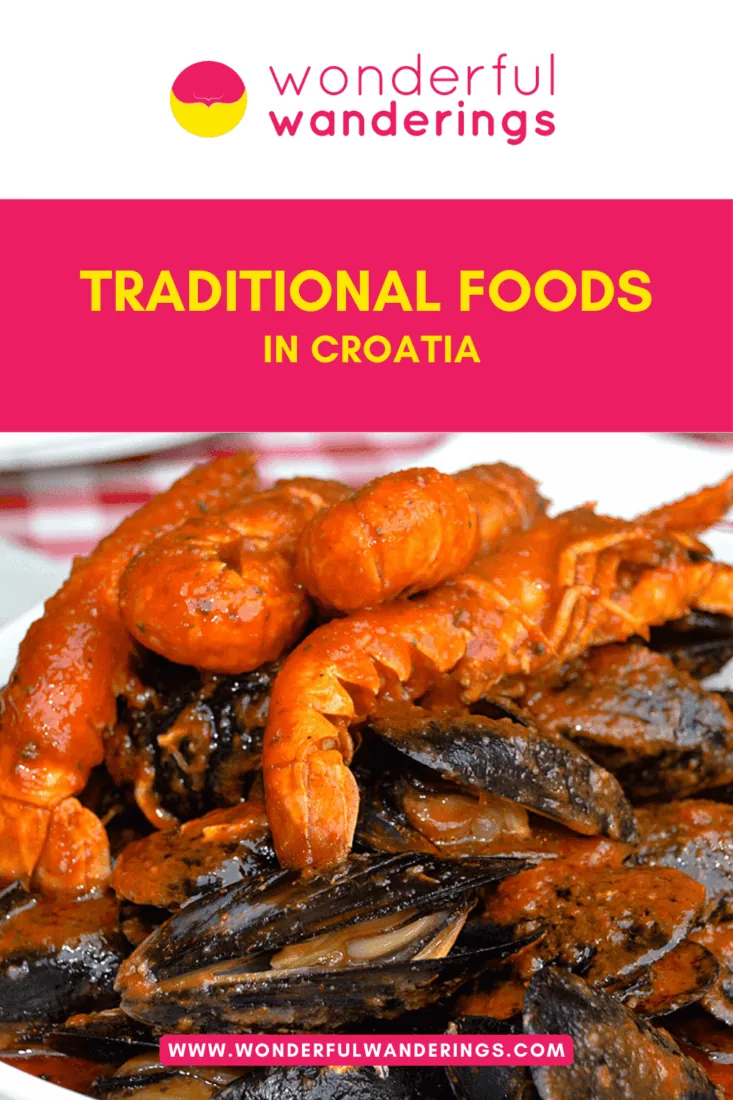Croatia is between central Europe and the Mediterranean. The capital and largest city is Zagreb, an inland continental area with paprika-spiced dishes like štrukli dumplings reflecting Hungarian/Austrian rule. This blend of climatic influences leads to a fusion of continental and coastal cuisine. Inland areas see heartier, meat-based dishes suited to the colder climate and forests, like game goulash and roasted meats. Mild Mediterranean coastal regions utilize abundant seafood, olive oil and herbs like rosemary. Croatia’s rugged terrain enables sheep farming and cheese production. Fertile lowlands supply vegetables and paprika and the bora wind helps dry pršut ham. Truffles thrive in nutrient-rich Istrian soil. Croatia’s extensive coastline and islands provide endless fresh seafood. Microclimates from mountains to coast create distinct regional cuisines but shared key ingredients connect Croatia to the broader Mediterranean, which features products such as olive oil, wine, pršut ham, artisanal cheese and seafood. Seasonality also impacts food culture. Colder months enable meat stews, air-dried hams and hearty baked bread. Warmer seasons celebrate produce through light dishes like stuffed peppers, fresh salads and seafood delicacies.
Listed below are traditional Croatian foods.
- Peka. Peka is a Croatian cooking technique where meat, seafood or vegetables are baked under a bell-shaped cast iron lid buried in hot coals for 1-3 hours. Best enjoyed freshly baked in family-style konoba taverns in Zagreb. Peka highlights succulent flavors and textures. It is typically served with bread to soak up pan juices.
- Crni rižot. Crni rižot is a black risotto made by cooking rice in squid or cuttlefish ink. Often contains additional seafood like squid, shrimp or mussels. Best served piping hot in Zagreb restaurants using Adriatic seafood. It is best to pair with white Croatian wines.
- Fritule. Fritule are sweet deep-fried doughnuts, a beloved Christmas tradition in Croatia. Best enjoyed freshly fried, crisp on the outside and soft inside, plain or dusted with powdered sugar. Often served with coffee or sweet wine. It is sold at holiday markets in Zagreb.
- Paški Sir. Paški sir is a hard, salty sheep milk cheese from Pag Island. It gets a distinctive flavor from the sheep’s diet of herbs. It is best served at room temperature to highlight a tangy, salty kick. Locals enjoy the cheese with cured meats, grapes and honey. It is available at Zagreb cheese shops and markets.
- Fuži. Fuži is homemade twisted pasta from Croatia’s Istrian peninsula. It is topped with rich meat or vegetable stews like game goulash. It is best served hot from the pan in Zagreb’s traditional konoba taverns, which use high-quality Istrian ingredients. It is quite nutritious, made from egg, olive oil and durum flour.
- Štrukli. Štrukli is Croatian stuffed dumplings with sweet or savory fillings like cheese, fruit, nuts and meat. Originated in the Zagorje region and is now popular nationwide. It is best served fresh and hot when the dough is still crispy and the filling oozes out. It is often the main dish, served with salad, meat and gravy.
- Ćevapi. Ćevapi are small skinless grilled sausages, considered Croatia’s national dish. It is a mix of ground beef, lamb and pork. Best in Zagreb čevabdžinice restaurants, stuffed in flatbread with onions, kajmak and ajvar. The dish provides protein and iron when enjoyed occasionally.
- Brudet. Brudet is a flavorful Croatian seafood stew with white fish, shellfish, tomatoes, onions and a specialty of Adriatic coastal cities. It is best served piping hot in konoba taverns. There is also a healthy option with lean proteins, olive oil and herbs. Bread on the side is essential when eating Brudet.
1. Peka
Peka (pronounced “peh-kah”) is a Croatian cooking technique and the name of the bell-shaped cast iron baking lid used in the process. Meat, seafood or vegetables are placed in a baking pan or directly on the hot coals, covered with the metal peak lid and buried under more hot coals to cook for 1-3 hours. Peka is best served piping hot in Croatia, directly from the pan or off the coals. The meat and vegetables soak up juices and flavors, becoming extremely tender and producing a delicious smoky aroma. Peka is meant to be shared family-style. A loaf of bread is always present to soak up the pan juices.
The best places to eat peka in Zagreb are traditional family-run taverns called konobas. Konobas in Zagreb take pride in their peka, using local recipes passed down through generations and cooking over open fires. Popular konobas known for excellent peka in Zagreb include Konoba Didov San and Konoba Kod Ruže. Peka is considered relatively healthy as it uses simple, whole-food ingredients like meat, vegetables, olive oil, garlic and herbs. The large amounts of oil and extended cooking times mean it is high in calories. Eating peka in moderation can be part of a balanced diet when visiting Zagreb.
There are many variations of peka depending on the region and ingredients used. Common proteins are lamb, veal, octopus, chicken or fish. Potatoes and onions are staples, while carrots, tomatoes, bell peppers, zucchini and eggplant can be added. Herbs like rosemary, thyme, sage and bay leaves infuse flavors. A garlic-infused olive oil is often drizzled over peka, perfectly combining the smoky, savory flavors. Dalmatian peka, especially octopus, pairs wonderfully with local white wines like Malvazija. Fresh bread is also essential for soaking up pan juices.
2. Crni rižot
Crni rižot (pronounced “tsarni ree-zhot”), known in English as black risotto, is a rice dish made by cooking arborio rice in squid or cuttlefish ink, giving it a dramatic black color. Additional seafood like squid, shrimp or mussels are often cooked right into the risotto. Crni rižot is best served along the Adriatic coast in Croatia, where the freshest seafood can be obtained. It is usually served as a starter or main course, piping hot straight from the pan in which it was cooked. The jet-black color is eye-catching and enhances the sweet brininess of the seafood. Crni rižot is ideally paired with a light white Croatian wine like Malvazija to balance the richness.
The best places to eat crni rižot in Zagreb are traditional restaurants that source fresh seafood from the Adriatic coast. Popular spots include Ribice i Tri Točkice, Takenoko and Dubravkin Put, which pride themselves on excellent crni rižot made with seasonal seafood and vegetables.
Crni rižot is relatively healthy as far as risottos go since it uses olive oil instead of butter, lots of vegetables like onions, garlic, tomatoes and protein-rich seafood. The city’s top restaurants bring fresh seafood daily from the coast to serve signature dishes like crni rižot. Eaten in moderation as part of a balanced diet, crni rižot can be quite nutritious.
There are many variations of crni rižot depending on the type of seafood used. Common proteins are squid, shrimp, mussels and mixed shellfish. Other vegetables like zucchini or bell peppers may be added to the dish. Some versions are quite spicy with added chilies. Depending on preference, the rice can be cooked anywhere from al dente to a creamy, porridge-like consistency. No extra sauce is needed for crni rižot due to the rich, seafood-infused, inky broth created by the cooking process. A drizzle of lemon or a grind of black pepper can provide some extra zing. Crni rižot also goes well with garlic-rubbed grilled bread for dipping into the dark juices.
3. Fritule
Fritule (pronounced “freet-oo-leh”) is a sweet fried doughnut or fritter, a beloved Christmas tradition in Croatia. Known as “Croatian doughnuts” in English, they are a specialty dessert served around the holidays. The best way to enjoy fritule is piping hot right after frying. Fritule are crispy on the outside and soft on the inside and are best eaten plain or lightly dusted with powdered sugar. Fritules are often served with hot black coffee or sweet wine, which balances the sweetness.
The best places in Zagreb to sample fritule are Christmas markets in the city center in December. Locals sell them fresh from street stalls or mobile fritule trucks. Konoba Matejuška in Zagreb is also famous for its fritule. Fritule are not the healthiest dessert since they are deep-fried. These are meant to be enjoyed in moderation during the holidays. It uses simple ingredients like flour, yeast, eggs, sugar, butter, rum, lemon and oil. Eating fritule is fine as part of a balanced diet for those visiting Zagreb.
There are a few variations of fritule across regions. Some are made with potato dough or corn flour instead of wheat flour. Fillings also differ – some are stuffed with walnuts, dried fruits or chocolate. The most traditional are plain with just a dusting of powdered sugar or glazed with honey. Fritule do not require a sauce since they have a sweet, cake-like texture. Only a sprinkle of powdered sugar or a drizzle of honey allows the flavor to shine. Cream or chocolate sauce can be served on the side for extra decadence.
4. Paški sir
Paški sir (pronounced “pah-skee seer”), known in English as Pag island cheese or Pag cheese, is a hard, salty cheese made exclusively on the Croatian island of Pag from the milk of indigenous Paška sheep. Pag cheese gets its distinctive flavor from the sheep’s diet of aromatic herbs like sage and sea fennel growing on the rocky, windswept land. Paški sir is best served at room temperature, simply sliced or broken apart and eaten plain. Locals also enjoy it shaved over salads, risottos and pasta or paired with cured meats, figs, grapes, olives and Pag’s famous sage honey. A drizzle of extra virgin olive oil highlights the salty, tangy flavors.
Paški sir is a specialty cheese made only on the island of Pag in Croatia. Some of the best places in Zagreb to try are cheese shops like Dukat, Zlatni Sir and Sir i Svrha, farmer’s markets and traditional konobas (taverns) that source high-quality regional ingredients. Visitors can often try or purchase cheeses like fresh cow cheese, sheep cheese, smoked cheese and cheese with herbs or spices. These Croatian cheeses provide protein, calcium, probiotics and vitamins found in milk. Quality cheeses from Zagreb or the surrounding region can be quite nutritious when enjoyed in moderation as part of a balanced diet. The key is seeking out authentic, small-production cheeses at specialty food shops around the city.
There are a few variations of Paški sir depending on aging. Young Pag cheese aged 2-7 months is semi-soft, mild and lightly salty. Aged Paški sir is left to mature for a year or more, intensifying the flavors and acquiring a grainy texture and crystalline crunch. There are also versions like Sirana Gligora’s award-winning cheese aged in wine residue. No extra sauce is needed to enjoy Paški sir due to its inherent tangy, salty kick. Extra virgin olive oil or a drizzle of honey nicely complements the savoriness. Pag wine like Žlahtina or Malvazija pairs beautifully with the dish.
5. Fuži
Fuži (pronounced “foo-zhee”) is a type of homemade pasta traditional to the Istrian peninsula of Croatia. Known as “Istrian twists” or “Istrian fusilli” in English, fuži gets its name from the Italian word “fuso” meaning spindle, describing its twisted shape. Fuži is best served in Istria as part of a main course, topped with rich meat or vegetable stews and sauces. The most classic is fuži with game goulash (šugo) made of veal or venison. They are also delicious with truffle cream sauce, tomato-based meat sauces or seafood stews. Fuži is typically served hot, directly from the pan in which it was cooked.
The best places to eat fuži in Zagreb are traditional family-run konoba taverns that source high-quality ingredients from Croatia’s Istrian peninsula. Popular spots serving excellent fuži pasta dishes include Konoba Didov San, Takenoko Zagreb and Konoba Kod Ruže. The fuži at these Zagreb taverns is made fresh using traditional techniques and recipes passed down through generations. These eateries pride themselves on bringing in premium olive oil, durum flour, eggs and other ingredients from Istria to craft authentic fuži. This type of pasta is quite nutritious, made from simple whole-food components like eggs, olive oil and durum wheat flour. When enjoyed in moderation as part of an overall balanced diet, fuži can be a healthy food choice for visitors to Zagreb.
There are a few variations of fuži across Istria. Some versions use potato dough or corn flour instead of wheat flour. Fillings also differ – some fuži are stuffed similarly to ravioli. The most traditional are plain, served simply with toppings and sauce. The rich meat and truffle sauces coating fuži provide plenty of flavor, but extras like grated hard sheep’s cheese, olive oil and garlic add even more delicious dimensions. Fuži also pairs beautifully with Istrian wines like Malvazija, Teran and Muškat.
6. Štrukli
Štrukli (pronounced “shtrook-lee”) are a type of filled dumpling from Croatia made of unleavened dough and various fillings. Known as “Croatian cheese dumplings” or “Zagorje štrukli” in English, they originated in the Zagorje region but are now beloved across Croatia.
Štrukli is best served freshly baked or boiled straight from the oven or pot when the outer dough is still crispy and the filling oozes. They are quite heavy and meant to be a main dish, served hot, often with salad, meat or gravy on the side to balance the richness.
The best places in Zagreb to sample excellent štrukli are the traditional family-run konoba taverns that source high-quality ingredients from Croatia’s Zagorje region. Popular spots serving superb štrukli dishes include Konoba Didov San, Takenoko Zagreb and Konoba Kod Ruže.
The cream and cheese fillings are high in fat and calories and the dough is quite nutritious, made from simple ingredients like eggs, flour and olive oil. These eateries pride themselves on using authentic recipe techniques from the Zagorje region to craft their štrukli. Enjoyed occasionally, štrukli can be part of a balanced diet for visitors to Zagreb.
There are many variations of štrukli depending on the filling, which ranges from sweet to savory. The most common is a soft cheese like cottage cheese, sometimes mixed with sour cream or eggs. Other popular versions use walnuts, apples, plums, cherries, chocolate or savory fillings like meat or mushrooms. No sauce is required for štrukli, as the creamy or sweet fillings provide plenty of moisture and flavor. Meat-based gravies are often served with mushroom or meat-filled štrukli. A garlic and olive oil dressing also complements some fillings.
7. Ćevapi
Ćevapi are small skinless grilled sausages made of ground beef, lamb and pork seasoned simply with salt, pepper and garlic. It is considered Croatia’s national dish and is served everywhere. Ćevapi are best served piping hot straight from the grill in Croatia. The ideal way to eat them is inside lepinje (flatbread) with chopped raw onions, kajmak (thick fermented milk cream), ajvar (roasted red pepper sauce) and sudžuk (beef sausage). This classic combination of flavors and textures is the perfect ćevapi experience.
Some of the best places in Zagreb to try ćevapi are the čevabdžinice (ćevapi restaurants) in the city center, where visitors can sample different regional styles imported from all over the Balkans. Famous Zagreb čevabdžinice include Željo, Mali Bar and Didov San. The meat and spices provide protein, iron and some vitamins. It can be enjoyed occasionally as part of a balanced diet.
There are regional variations of ćevapi across Bosnia and Herzegovina that can be found in Croatia too. Banja Luka-style are made into little meat tiles of four connected finger-shaped ćevapi. Travnički ćevapi contains veal and baking soda for extra tenderness. Tuzlanski ćevapi uses beef in a 2.1.1 ratio of ground chuck, rib meat and flank. No extra sauce is needed to enjoy ćevapi properly, as kajmak cream and ajvar provide plenty of moisture and flavor contrast. Yogurt-based sauces can be dipped on the side, especially with pljeskavica (Balkan hamburger patties).
8. Brudet
Brudet (pronounced “broo-det”) is a type of fish stew that is a specialty dish along the Adriatic coastline of Croatia. It is known as “Croatian fish stew” in English. Brudet is best served piping hot, straight from the cooking pot in Croatia. It has a delicious medley of flavors from various fish and seafood and aromatics like onion, garlic, tomatoes and white wine. Brudet is ideally served family-style, with a loaf of crusty bread on the side to soak up the pan juices.
The best places to eat brudet in Zagreb are traditional konoba (tavern) restaurants that source fresh seafood daily from the Dalmatian Coast. Excellent seafood makes its way from coastal cities and islands to the capital. Popular spots to try high-quality brudet in Zagreb include Konoba Didov San, Takenoko and Pod Gričkim Topom. Brudet can be a relatively healthy dish, primarily using lean white fish, shellfish, tomatoes, onions, olive oil and herbs. The cooking method and oil can also make it high in calories. Brudet can be part of a balanced diet when enjoyed occasionally.
There are many regional variations of brudet across Croatia, depending on which seafood is local and fresh. Common proteins are white fish like sea bass, sea bream, grouper, monkfish, scorpionfish or eel and shellfish like mussels, clams, shrimp or squid. Octopus or crab may also be added. No extra sauce is needed for brudet, as the stewing process creates an incredibly complex seafood broth full of flavor. A drizzle of olive oil, lemon wedge or dipping good bread into the juices takes it to another level.
9. Skradinski rižot
Skradinski rižot (pronounced “skrah-deen-skee ree-zhot”), known as “Skradin risotto” in English, is a rich, creamy rice dish made by braising veal and onions in meat broth for hours until the veal falls apart into a thick sauce, then cooking rice in the sauce. Skradinski rižot is best served piping hot, straight from the pot, in Croatia, ideally with a crisp white wine like a Dalmatian Malvazija. The long cooking concentrates flavors for an incredibly savory, unctuous dish with fall-apart tender veal suspended throughout. Locals scoop it up with crusty bread.
Skradinski rižot is a local specialty of Skradin along the Krka River, so it would not be authentic to Zagreb, but the city offers the best places to sample this dish. The best places in Zagreb to sample flavorful risottos are family-run konoba taverns that source high-quality ingredients across Croatia. Popular spots serving excellent risottos in Zagreb include Konoba Didov San, Takenoko Zagreb and Pod Gričkim Topom. These eateries pride themselves on crafting risottos with care and precision using traditional techniques passed down through generations. Rich, creamy risottos with various ingredients like mushrooms, vegetables or meats can be found on menus across the city. Risottos provides protein, vitamins and minerals from quality ingredients. Moderation is key to incorporating indulgent regional specialties like risottos in a healthy way.
There are few variations of Skradinski rižot as recipes are closely guarded family secrets. In some versions, add prosciutto, use chicken stock instead of or with beef or finish with sheep’s milk cheese. The basics remain veal, onions, rice and a rich stock. No sauce is needed for Skradinski rižot due to the veal and beef pan sauce created after hours of reduction. Locals often drizzle olive oil or dip crusty bread to soak more juices.
10. Pašticada
Pašticada (pronounced “pah-stee-tsah-dah”), known in English as Dalmatian beef stew or Dalmatian pot roast, is a beloved beef dish from the Dalmatia region of coastal Croatia. It features long and slow beef in a rich, fragrant, sweet-sour sauce made with vegetables, wine, vinegar and dried fruits like prunes or figs. Pašticada is best served piping hot from the cooking pot or oven. The long braising results in extremely tender, fall-apart beef bathed in a luscious sauce redolent of herbs and subtly sweet flavors. It is meant to be served family-style with crusty bread for soaking up juices. Potato gnocchi or homemade pasta are traditional accompaniments.
The best places in Zagreb to sample excellent pašticada are traditional family-run konoba taverns that source high-quality ingredients from Croatia’s Dalmatian Coast. Popular spots serving superb pašticada dishes include Konoba Didov San, Takenoko Zagreb and Pod Gričkim Topom. These eateries pride themselves on using authentic recipes and techniques from the Dalmatian region to craft their pašticada. The dish is high in fat and calories due to the liberal use of oil and red wine but provides protein from beef and vegetables. Enjoyed occasionally in moderate portions as part of an overall balanced diet, pašticada can be a tasty component of meals in Zagreb.
There are regional variations of pašticada across Dalmatia based on locally available ingredients. Some versions use lamb or game instead of beef. Dried fruits range from prunes, figs and raisins to apples or pears. These key elements require long marinating, slow braising and a balanced sweet-sour sauce. No extra sauce is needed for pašticada due to the vegetable and pan juice sauce created by the cooking process. Locals often drizzle olive oil or dip crusty bread into the juices. Dalmatian Malvazija or Plavac Mali wines pair beautifully with Pašticada.
11. Salata od hobotnice
Salata od hobotnice (pronounced “salata od hoboat-nit-seh”), known as “Octopus Salad” in English, is a common appetizer or light meal of octopus boiled then chopped and dressed simply with olive oil, vinegar, garlic, parsley and vegetables. Salata od hobotnice is best served chilled, as the fresh, tangy flavors are meant to awaken the palate. It is usually served as a starter dish in Croatia, either on its own or over a bed of leafy greens, with crusty bread on the side. The tender octopus and bright dressing make for a perfect warm-weather lunch.
The best places in Zagreb to eat salata od hobotnice are traditional konoba taverns that source fresh octopus daily from the Dalmatian Coast. Popular spots include Konoba Didov San, Takenoko and Pod Gričkim Topom. These eateries pride themselves on serving seafood dishes like salata od hobotnice using the freshest ingredients. The octopus is low in fat. As a seafood salad, it is relatively healthy, especially when served without starchy potatoes. The olive oil dressing, garlic and parsley provide healthy fats, antioxidants and vitamins. Enjoyed occasionally as part of a balanced diet, salata od hobotnice can be a tasty and nutritious choice in Zagreb.
There are many regional variations of salata od hobotnice, most often in the additional vegetables used. Some versions add tomatoes, onion, roasted red peppers or greens like arugula. Others include boiled new potatoes. More rustic versions may even incorporate the octopus skin for texture. No sauce is needed for salata od hobotnice, as the simple oil and vinegar dressing provides plenty of bold flavors. The tanginess of the salad makes it the perfect pairing for Dalmatian white wines like Malvazija.
12. Sarma
Sarma (pronounced “sar-mah”) are rolls of cabbage stuffed with a mix of meat and rice. Sarma, also known as “stuffed cabbage rolls”, is a specialty across the Balkans, Turkey and Eastern Europe. Sarma is best served warm, straight from the oven or pot in which it was cooked in Croatia. The stuffed cabbage rolls soak delicious flavors from the braising liquid during cooking. Sarma is quite heavy and is usually served as a main course, with crusty bread, pickles and yogurt or sour cream on the side.
Some of the best places to eat sarma in Zagreb are traditional restaurants and taverns specializing in dishes from Croatia and the wider Balkan region. Well-known spots include Konoba Didin Konak, Pod Gričkim Topom and Takenoko Zagreb. Sarma provides protein from the meat and carbs from the rice. The cabbage also offers some fiber and nutrients. Enjoyed occasionally, sarma can be part of a balanced diet. Vegetarian versions substitute mushrooms or tofu for meat.
There are some variations of sarma across regions and cultures. The stuffing differs from pork, beef, lamb or chicken mixed with rice, onions, carrots, garlic and herbs. The cooking method varies, including baking, simmering in broth or steaming in large pots. No sauce is needed for sarma due to the rich pan juices and braising liquid. Yogurt or sour cream often accompanies sarma to contrast the dish’s richness. Ajvar (roasted red pepper spread) is also a popular condiment.
13. Istarski pršut
Istarski pršut (pronounced “eestarskee puh-shoot”), known as “Istrian prosciutto” in English, is a specific type of dry-cured ham made exclusively in the geographical region of the Istrian peninsula in Croatia. It has Protected Designation of Origin (PDO) status in the EU. Istarski pršut is best served thinly sliced at room temperature, allowing the salty, sweet and savory flavors to shine. Locals enjoy it simply as an appetizer with olives, cheese, bread, figs and Dalmatian Malvazija white wine. Shaved over risottos, pasta or salads is also popular.
The best places in Zagreb to sample Istarski pršut are traditional konoba taverns and specialty food shops that source high-quality artisanal pršut from renowned smokehouses in Istria. Popular spots serving superb pršut dishes include Konoba Didov San, Takenoko Zagreb and Pod Gričkim Topom. These eateries pride themselves on using pršut made with traditional techniques perfected by producers like Pršutana Rašp and Pršutana Lindić in Istrian towns such as Motovun, Buzet and Buje. Pršut from Istria can be part of a balanced diet for visitors to Zagreb.
There are a few variations of Istarski pršut depending on the length of aging. Pršut aged 12 months, is lightly salty with a soft texture. Pršut aged 18 months or longer intensifies in flavor and takes on a deeper red color and crystalline crunch in the meat. White mold also grows, adding flavor. No sauce is needed to enjoy Istarski pršut properly due to its inherent salty, sweet and savory flavors. Extra virgin olive oil and garlic nicely complement the dish. Dalmatian Malvazija white wine is another excellent pairing.
14. Mlinci
Mlinci (pronounced “mlin-tsee”), known as “baked noodles” in English, are a type of flatbread pasta dish originating from the Zagorje region of northern Croatia and parts of Slovenia.
Mlinci are best served hot, directly from the oven or pan in which they were cooked to absorb the flavors. They have a unique crispy yet soft soaked bread-like texture. Mlinci accompanies roasted meats like turkey, chicken or duck. The flatbread pieces soak up the savory juices beautifully. Locals also enjoy mlinci crunchy plain as a snack.
Some of the best places to sample mlinci are the traditional family-run konoba taverns in Zagreb that source high-quality ingredients from Croatia’s Zagorje region. Popular spots serving excellent mlinci dishes include Konoba Didov San, Takenoko Zagreb and Konoba Kod Ruže. These eateries pride themselves on using authentic recipes and techniques from the Zagorje region to craft their mlinci. Mlinci is typically served coated in meat pan drippings or butter, which increases the fat and calorie content. Enjoyed occasionally in moderation as part of an overall balanced diet, mlinci can be a tasty and healthy component of meals in Zagreb.
There are a few variations of mlinci depending on the cooking method. The dough can be baked in the oven, fried on the stovetop or cooked over an open fire. There are also sweet versions served dusted with powdered sugar or honey. But the most classic is plain, soaked in meat juices. No extra sauce is required for mlinci, as the meat pan juices provide plenty of moisture and savoriness. Meat gravies are often served alongside oven-baked versions. Mlinci also pairs well with sauerkraut, horseradish or yogurt.
15. Punjena paprika
Punjena paprika (pronounced “poon-yena pah-pri-kah”), known as “stuffed peppers” in English, is a beloved dish of bell peppers stuffed with a flavorful filling of meat, rice, vegetables and spices. Punjena paprika is best served warm, straight from the oven, in countries like Bosnia, Serbia, Croatia and Bulgaria, where it is considered a specialty. The stuffed peppers soak delicious flavors from the filling and braising liquid during baking. Punjena paprika is quite heavy, so it’s usually served as a main course with crusty bread, yogurt or mashed potatoes to balance the richness.
Some of the best places in Zagreb to eat authentic punjena paprika are the family-run taverns (konobas) specializing in dishes from Croatia and the wider Balkan region. Well-known spots include Konoba Didin Konak, Pod Gričkim Topom and Takenoko Zagreb. Punjena paprika provides protein and makes use of bell peppers and onion. Enjoyed occasionally, it can be part of a balanced diet. There are also vegetarian versions of substitutes for meat, like mushrooms or tofu. There are some variations of punjena paprika across regions and cultures. The filling differs from pork, beef, lamb or chicken mixed with rice, onions, carrots, garlic and herbs. The cooking method also varies between baking and simmering in broth. No extra sauce is needed due to the rich pan juices and braising liquid. Yogurt or ajvar (red pepper spread) often accompanies punjena paprika to contrast the richness.
16. Burek
Burek (pronounced BOO-rek) is known as “baked filo pie” in English. It is a specialty of Balkan cuisine, especially popular in Bosnia and Herzegovina, Serbia, Croatia and Turkey. Burek consists of many layers of thin filo dough filled with meat, cheese, spinach, potato or other fillings. Burek is best served freshly baked and piping hot in Croatia. The crisp, flaky filo soaks up the juices from the filling, ranging from spiced ground meat to melty cheese to sautéed spinach. Burek is meant to be eaten by hand, straight from the pan, with the filo cracking and flaking apart.
Some of the best places in Zagreb to eat burek are small bakeries focusing specifically on producing traditional versions of this iconic dish. Famous spots include Stari Fijaker and Didov San, which serve excellent cheese, meat or spinach burek. Burek can be part of a healthy diet when enjoyed in moderation. The filo dough contains few ingredients and the traditional fillings provide protein. There are many regional variations of burek across the Balkans. Fillings can range from spiced ground beef to feta cheese to mashed potatoes, with spinach, pumpkin, mushroom and fruit fillings also used. No extra sauce is needed to enjoy burek, as the filling provides plenty of moisture and flavor contrast to the crisp, flaky filo. Strained yogurt is often served alongside to balance out the richness. Ajvar (red pepper relish) and kajmak (fermented milk cream) also pair nicely.
17. Zagrebački odrezak
Zagrebački odrezak (pronounced “zah-gre-bah-tskee oh-dreh-zahk”), known as “Zagreb steak” in English, is a thin veal cutlet stuffed with ham and cheese, breaded and fried. It originated in Zagreb as a variation on the French dish Cordon Bleu and Swiss Schnitzel. Zagrebački odrezak is best served freshly fried in Zagreb when the crust is still crispy and the cheese is melted and gooey. It is typically served with rice or french fries to soak up the pan juices. Lemon wedges are provided to squeeze over the steaks for added moisture and tang.
The best places in Zagreb to eat authentic, well-prepared Zagrebački odrezak are traditional restaurants called konobas that have perfected family recipes passed down through generations. Famous Zagreb konobas serving excellent Zagrebački odrezak include Konoba Didin Konak and Konoba Stari Fijaker. Zagrebački odrezak provides protein from the veal and ham. The dish can be part of a balanced diet and lighter versions can be made by baking instead of frying. There are some regional variations of Zagrebački odrezak. pork or chicken is sometimes substituted for veal. Different cheeses like gouda or edam can be used for the filling. Spicy or sweet paprika may be added to the breading mixture. But the basic stuffed cutlet preparation remains the same. No sauce is needed for Zagrebački odrezak, as the cheese filling provides plenty of richness and moisture. Dipping the steaks in lemon juice provides some welcome fresh tartness to cut through the fried flavor. Tartar sauce is also a popular condiment.
18. Čobanac
Čobanac (pronounced “choh-bah-nats”), known as “shepherd’s stew” in English, is a hearty meat and vegetable stew that originated in the continental regions of Croatia. Shepherds traditionally cooked it outdoors in copper cauldrons over an open fire. Čobanac is best served piping hot, straight from the pot or cauldron in Croatia. The long-simmering results in extremely tender meat and vegetables soaked in a rich, paprika-infused broth. Čobanac is meant to be served family-style with crusty bread to soak up the delicious pan juices.
The best places in Zagreb to sample excellent čobanac are the traditional family-run konoba taverns that source high-quality ingredients from Croatia’s inland regions like Slavonia and Zagorje. Popular spots serving superb čobanac dishes include Konoba Didov San, Takenoko Zagreb and Pod Gričkim Topom. These eateries pride themselves on using authentic recipes and techniques from Slavonia and Zagorje to craft their čobanac. This meat and vegetable stew provides protein, vitamins and minerals. It can occasionally be enjoyed in moderate portions as part of a balanced diet. There are regional variations of čobanac across Croatia based on locally available ingredients. The meat varies, with beef, lamb, pork, venison and poultry used. Spiciness also differs; paprika is essential, but hot peppers can be added. The basics of meat, onions, paprika and potatoes cooked for hours remain the same. No extra sauce is needed due to the rich, flavorful broth. Croatians often dip crusty bread into the juices to soak up every last bit. Čobanac also pairs wonderfully with regional white wines like Graševina.
19. Rožata
Rožata (pronounced “roh-zha-tah”), known as “Croatian caramel custard” or “Dubrovnik caramel cream” in English, is a traditional dessert from the Dalmatia region of coastal Croatia, especially popular in Dubrovnik. It is a custard made of egg, milk, sugar and flavorings, topped with bittersweet caramelized sugar. Rožata is best served chilled, directly from the ramekin or mold in Croatia. The contrast between the cold, creamy custard and the hard caramel topping makes it a must-try. It is usually served as a finale to a meal, sometimes with fresh berries or whipped cream as accompaniment. The elegant presentation makes it perfect for special occasions.
Some of the best places in Zagreb to enjoy excellent rožata are traditional restaurants and family-run konobas that use time-honored recipes brought over by families from the Dalmatian Coast region. Popular spots for rožata in Zagreb include Konoba Didov San, Takenoko and Pod Gričkim Topom. Rožata provides protein from the eggs and calcium from the milk used to prepare this custard-style dessert. These eateries pride themselves on crafting authentic versions by following traditional techniques and recipes learned from prior generations. Rožata can be a tasty treat to try in Zagreb. There are some variations of rožata depending on the region. Some versions have a more cake-like consistency and are made with flour or cornstarch. Fillings like chocolate or fruit may be added. But traditional Dubrovnik-style rožata is creamy, with no flour added. No extra sauce is needed for rožata, as the custard and caramel provide plenty of flavor and sweetness. It is often presented with fresh berries, mint leaves or whipped cream as a garnish.
20. Orahova potica
Orahova potica (pronounced “orahova poh-teet-sah”), known as “walnut roll” in English, is a beloved Croatian rolled pastry made from a sweet yeast dough filled with a rich walnut filling. Potica is considered one of Croatia’s national dishes. Orahova potica is best served at room temperature in Croatia, sliced to reveal the swirled walnut filling inside the tender, lightly sweet dough. It is usually eaten as a dessert or coffee accompaniment, making an excellent breakfast pastry. Locals enjoy potica year-round, but especially for holidays like Christmas and Easter.
The best places in Zagreb to sample orahova potica are traditional Croatian konobas (family-run taverns) that have perfected recipes passed down through generations. Well-known spots include Konoba Didin Konak, Konoba Kod Pere and Konoba Stari Fijaker. Orahova potica provides protein, vitamins and minerals. It can be part of a balanced diet when enjoyed occasionally in moderate portions. There are many variations of potica fillings across Croatia’s regions and the walnut version remains the most classic. Common fillings include sweet cheese, poppy seeds, raisins, apples, plums, cherries and chocolate. Savory potica with meat or mushroom fillings also exists. No extra sauce is needed to enjoy orahova potica, as the filling provides plenty of moisture and flavor contrast to the soft, lightly sweet dough. Powdered sugar is often sprinkled over the top crust and ice cream or fruit compotes can be lovely accompaniments.
21. Kremšnita
Kremšnita (pronounced “krem-shnee-tah”), known as “custard slice” or “cream slice” in English, is a layered cake made of puff pastry, vanilla custard and whipped cream. It is a specialty dessert from Croatia that is especially popular in Samobor near Zagreb. Kremšnita is best served chilled in Croatia directly from the fridge. The contrast between the crisp, flaky pastry and the cool, creamy custard fillings makes it a must-try. Kremšnita is usually served as a finale to a meal, sometimes with berries, chocolate shavings or mint leaves as garnish.
The best places in Zagreb to sample excellent kremšnita are traditional Croatian konobas (family-run taverns) that have perfected recipes passed down through generations. Well-known spots include Konoba Didin Konak, Konoba Kod Pere and Konoba Stari Fijaker. The liberal use of cream, eggs and pastry, kremšnita provides some protein and calcium. It can be part of a balanced diet when enjoyed occasionally in moderate slices. There are a few variations of kremšnita across regions. Some versions have a more cake-like consistency, with flour or cornstarch added to the custard. Fillings like chocolate or fruit may be used as well. But the classic is layered with plain custard and whipped cream. No extra sauce is needed for kremšnita, as the custard and whipped cream provide plenty of richness and sweetness. It is often beautifully presented with fresh berries, mint leaves or chocolate shavings.
22. Kulen
Kulen (pronounced “koo-len”) is a cured and smoked sausage made of finely minced pork and spiced with paprika and garlic. It is traditionally produced in the regions of Slavonia and Baranja in Croatia. Known as “Slavonian sausage” in English. Kulen is best served in Croatia as an appetizer, sliced thin and eaten at room temperature to allow its signature smoky, spicy and salty flavors to shine. Locals enjoy kulen with a sharp sheep’s milk cheese like paški sir, crusty bread, mustard, pickles or figs and a glass of local white wine like Graševina.
Some of the best places in Zagreb to sample excellent kulen are shops and markets selling artisanal cured meats and cheeses across Croatia’s regions. Well-known spots include Mali Bar, Uje Oil Bar, Vinoteka Bornstein and Dolac Market. When enjoyed in moderation, kulen can be part of a healthy diet. The pork provides protein and nutrients like iron and vitamin B12. The paprika also offers antioxidants. A few slices make for an indulgent treat. There are a few variations of kulen depending on the region it’s produced, with differences in smoking time, spices used, etc. Kulen from Slavonia tends to be the most acclaimed. Some kulen is covered in an external white mold, adding extra flavor dimension. No extra sauce is needed to enjoy kulen properly due to its intense, smoky, spicy and salty kick. Mustard, horseradish, cornichons, fig jam and chutney can accompany nicely. Dry white wines like Graševina are a great pair to Kulen.
23. Pršut
Pršut (pronounced “pur-shoot”) is a dry-cured ham made from pork leg, similar to Italian prosciutto. Known as “Croatian prosciutto” or “Dalmatian prosciutto” in English. Pršut is best served thinly sliced at room temperature in Croatia, allowing its signature salty, sweet and savory flavors to shine. Locals enjoy it simply with cheese, olives, bread or fruit. Shaved over risottos, pasta or salads is also popular.
Some of the best places in Zagreb to sample excellent pršut are shops and markets that sell artisanal cured meats and cheeses from across Croatia’s regions. Well-known spots include Mali Bar, Uje Oil Bar and Dolac Market. While high in sodium and fat, typical of cured meats, when enjoyed in moderation as part of the Mediterranean diet, pršut provides protein, iron and vitamin B. Sea salt and herbs also provide some antioxidants and can be part of a balanced diet. There are four Croatian pršuts with Protected Designation of Origin (PDO) status, each with slight variations in production. Istrian, Krk Island, Drniš and Dalmatian pršut. Istrian pršut is skinned and coated in herbs during curing. Krk and Dalmatian pršut are cured with the skin on. Drniš pršut is smoked as well. No extra sauce is needed to enjoy pršut properly due to its inherent salty, sweet and savory kick. Extra virgin olive oil and garlic nicely complement it. Dalmatian Malvazija white wine is another excellent pairing.
24. Maneštra
Maneštra (pronounced “mah-nesh-trah”), known as “Istrian minestrone” in English, is a hearty vegetable and bean soup that originated in the Istria region of Croatia. It resembles the famous Italian minestrone but includes ingredients like sweet corn, prosciutto and vinegar, giving it a unique Istrian flair. Maneštra is best served piping hot, straight from the cooking pot, in Croatia. The long-simmering creates a wonderfully thick, flavorful broth studded with tender beans, vegetables and nubs of meat. Locals scoop it up with crusty bread to soak up every last bit of the pan juices.
Some of the best places in Zagreb to sample excellent maneštra are the traditional family-run taverns (konobas) that pride themselves on using recipes passed down for generations. Well-known Zagreb konobas to try maneštra include Pod Gričkim Topom, Mali Bar and Didin Konak. Maneštra provides protein, vitamins and minerals. The ingredients are simple and homemade. Enjoyed occasionally, it can be part of a balanced diet. There are many variations of maneštra across Istria depending on the season and ingredients used. Common additions include potatoes, tomatoes, onions, carrots, turnips, cabbage, pasta shells, corn, prosciutto bone, vinegar and olive oil. No extra sauce is needed due to the rich, flavorful broth created by long-simmering. Locals often drizzle some olive oil or dip crusty bread to soak up every last bit of the pan juices.
What are the signature dishes of Croatia that every visitor should try?
Listed below are the signature dishes of Croatia that every visitor should try.
- Crni rižot (Black risotto). Crni rižot is an iconic rice dish from the Dalmatian coast. It gets its black color and intense seafood flavor from cuttlefish or squid ink added during cooking. It likely originated among fishermen using seasonal seafood but became a coastal staple representing Croatian cuisine.
- Pašticada. Pašticada is a braised beef stew with vegetables, wine, vinegar and dried fruits like prunes or figs. Pašticada originated in Dalmatia and is considered celebratory fare reserved for holidays and special events in Croatia.
- Ćevapi. Ćevapi is a small grilled sausage made of minced meat, a combination of beef, pork or lamb. It is considered Croatia’s national dish and is served everywhere. Ćevapi likely originated during Ottoman rule in the Balkans but evolved to suit Croatian tastes.
- Peka. Peka is a Croatian cooking technique and the name of the bell-shaped cast iron baking lid is used in the process. Peka is best served piping hot in Croatia, directly from the pan or off the coals. The meat and vegetables soak up juices and flavors, becoming extremely tender and producing a delicious smoky aroma.
- Pršut. Pršut is air-dried ham made from pork legs that is salted, spiced and aged for up to a year in the coastal climate, resulting in an intensely flavored delicacy that is one of Croatia’s most prized regional products with a long-standing tradition.
- Kotlovina. Kotlovina is a pork roast dish originating in inland Croatia, often using meat from the indigenous Turopolje pig breed that forages in oak forests. The pork joints and vegetables are slow-cooked in a covered iron kettle called a kotao for many hours until extremely tender and flavorful. This hearty meat dish is considered a specialty of continental Croatia.
What foods are a must-try for first-time visitors to Croatia?
Listed below are the must-try foods for first-time visitors in Croatia.
- Ćevapi. Ćevapi is a small grilled sausage made of minced meat, a combination of beef, pork or lamb. It is considered Croatia’s national dish and is served everywhere. Locals commonly enjoy ćevapi for quick lunches or snacks. They can be found at restaurants, summer festivals, street food carts and markets year-round. Ćevapi offers a tasty introduction to regional seasonings like paprika, garlic and parsley. The spicy, herbal notes pair perfectly with the smoky grilled meat.
- Crni rižot. Crni rižot is a black-colored seafood risotto that gets unique color and flavor from adding squid or cuttlefish ink during cooking, giving it a hearty briny taste. Squid, shrimp or other types of seafood are often chopped and added to the risotto along with the ink. This specialty of the Dalmatian coast offers adventurous eaters a chance to try something entirely different and uniquely Croatian.
- Peka. Peka is an iconic cooking technique that yields exceptionally tender and flavorful meats or vegetables like octopus, lamb, veal or potatoes. The food items are placed in a metal bell-like lid called a peak, along with herbs, olive oil, tomatoes, onions, garlic and more. Peka captures the essence of Croatian comfort food in flavor and communal preparation. Peka is also an iconic dish that first-time visitors should try.
- Fritule. Fritule would make an excellent first-time visitor treat, as these sweet fried dough balls are a beloved tradition across coastal Croatia and offer visitors a taste of local holiday specialties. The fried dough’s raisins, lemon and brandy make fritule a delicious and unique snack.
- Paški sir. Paški sir is the famous sheep’s milk cheese from the island of Pag. Pag cheeses offer a tangy, salty and slightly sweet flavor profile that reflects the landscape and sheep of the region. First-time visitors to Croatia should try Pag cheese plain, grated over dishes or with olive oil to appreciate this specialty.
What are the local desserts in Croatia?
Listed below are the local desserts in Croatia.
- Rožata. Rožata is a traditional Croatian crème caramel dessert featuring a custard pudding made with egg yolks, milk, sugar and aromatics like lemon zest, then topped with caramelized sugar. It originated from family recipes in Dubrovnik and the Dalmatian region, where the addition of rose liqueur gives Rožata its distinctive regional name and flavor profile. This dessert is chilled, often garnished with whipped cream, berries or citrus peel.
- Fritule. Fritule are small sweet pastries resembling doughnuts that originated on the Croatian coast, made by deep-frying leavened dough with rum and raisins until crispy outside and soft inside, then rolling them in powdered sugar or granulated sugar. They are a beloved traditional dessert enjoyed at Christmas markets and Carnival celebrations in Croatia.
- Kroštule. Kroštule is thin sweet fritters made by deep-frying sweet yeast dough into crispy twists or ribbons that are then coated with powdered sugar or honey; this classic holiday dessert likely came to Istria, Croatia, from Austria-Hungary and is traditionally enjoyed during Carnevale season.
- Palacinke. Palacinke are thin crepe-like pancakes that are served with sweet or savory fillings in Croatia; common traditional dessert options spread like chocolate hazelnut paste, jam, cottage cheese or walnuts or palacinke can be rolled up with fillings.
- Orahovača. Orahovača is a rich walnut cake from northern Croatia near the Hungarian border that gets its flavor from freshly ground walnuts mixed into the batter before baking; it is often enjoyed with whipped cream or ice cream as a dessert in Croatia.
What are the best starters or snacks to eat in Croatia?
Listed below are the best starters or snacks to eat in Croatia.
- Paški sir (Pag cheese). Paški sir is a famous hard, salty sheep milk cheese that originates from the island of Pag in Croatia, where indigenous sheep graze on aromatic native herbs, imparting a unique flavor that makes Paški sir an iconic starter and symbol of both Pag and Croatia.
- Pršut (prosciutto). Pršut is air-dried ham made from pork legs that is salted, spiced and aged up to a year in the coastal climate of Croatia, resulting in an intensely flavored delicacy that is one of Croatia’s most prized starters, often served with cheese as the ultimate appetizer platter.
- Masline (olives). Masline is a starter in Croatia, with Istria renowned for its high-quality extra virgin olive oils made from local olive varieties and Dalmatia famed for its plump, briny oblique olives harvested from the fertile Neretva Valley that produce the ideal accompaniment.
- Fritule. Fritue is a sweet fried yeast dough pastry resembling miniature doughnuts that are beloved at Christmas markets and Carnival celebrations across Croatia, where powdered sugar-dusted fritule are enjoyed by the bagful still warm from the oil as a delicious seasonal starter.
- Pršut. Pršut is a type of air-cured ham made in the Istria region of Croatia that is aged for over a year, developing a unique sweet and salty flavor. Pršut is considered one of Croatia’s national delicacies and is a popular appetizer, often served paper-thin with olives, cheese like sheep’s milk Pag and crusty bread.
- Raznići (meat skewers). Raznići refers to mixed meat skewers commonly found sizzling at popular outdoor markets and summer festivals across Croatia, with beef, pork and lamb threaded onto a rotating spit alongside onions and bacon over a smoky open fire for a protein-packed, portable starter snack.
What are the best foods to eat for breakfast in Croatia?
Listed below are the best foods to eat for breakfast in Croatia.
- Burek. Burek is a popular savory pastry in Croatia, typically filled with cheese, meat or spinach. Croatians love to eat burek for breakfast, picking one up from a bakery on their way to work or school. Burek has been a breakfast staple in Croatia for decades.
- Jogurt s voćem. Jogurt s voćem is a thick creamy yogurt topped with fresh seasonal fruit. It is a light and refreshing way to start the day in Croatia. Jogurt s voćem has been commonly eaten at breakfast in Croatia since the country was part of Yugoslavia. Topping it with fruit adds vitamins and sweetness to balance the tangy dairy.
- Jaja i pršut. Jaja i pršut are fried, scrambled or poached eggs served with thin slices of dry-cured ham are a protein-packed breakfast in Croatia. Eggs from free-range chickens are easy to find in Croatia and make a satisfying breakfast. Prosciutto from Croatia’s Istria region is considered some of the finest in the world and pairs beautifully with eggs.
- Tartini. Tartini is an open-faced sandwich with cheese, cold cuts, vegetables or ajvar relish. They are a quick and tasty breakfast. Tartini has long been a way for Croatians to use up leftovers and freshly baked bread for breakfast. The combinations of toppings for tartines are endless, allowing creativity even early in the morning.
- Sir i vrhnje. Sir i vrhnje is a common breakfast in Croatia, with creamy dairy complemented by salty cheese. Soft cow’s milk cheeses are often produced in Croatia’s fertile grasslands, which provide excellent grazing. Combining cheese and sour cream makes for a protein-rich start to the day to fuel Croatia’s active population.
- Palačinke. Palačinke has been a breakfast staple in Croatia for generations, with sweet and savory versions enjoyed throughout the country. Croatians often stop at a local bakery on the way to work or school to pick up freshly made palačinke for breakfast on the go. The simplicity of ingredients in palačinke reflects Croatia’s ability to transform basic components into comforting, delicious meals.
What are the best street foods in Croatia?
Listed below are the best street foods in Croatia.
- Kremšnite. Kremšnite, a layered cream cake, is a beloved snack sold at bakeries and cake shops across Croatia. The sweet aroma of kremšnite fills Croatian streets as locals stop to enjoy a slice of the decadent dessert on the go. Kremšnite has been a favorite Croatian street food for generations with its crisp, flaky pastry and smooth, creamy filling.
- Ćevapi. Ćevapi are small grilled sausages made of minced meat, a popular street food in Croatia. Ćevapi can be found all over Croatian cities, with the aroma of grilled meat filling the streets. Ćevapi is typically served in a lepinja flatbread with onions and ajvar relish for a convenient and tasty bite while on the go.
- Palačinke. Sweet and savory palačinke are commonly sold from small stands and food trucks in Croatia as an easy street food option. The smell of palačinke cooking on griddles wafts through Croatian streets, drawing in hungry passersby. Palačinke stuffed with cheese, ham, chocolate or fruit makes for a warm, comforting snack for people running errands or sightseeing.
- Sir i vrhnje. Sir i vrhnje refers to fresh cheese and sour cream served together, a beloved casual street bite in Croatia. Vendors dish up the simple combination of creamy dairy and salty cheese at markets and small kiosks as a quick hunger fix for locals and tourists. The cheese and sour cream pairing can be found in town squares or at seaside resorts in Croatia.
- Langoši. Langoši, a type of deep-fried dough, joins burek and ćevapi as top savory street food options in Croatian city centers. The scent of freshly fried langoši draws hungry crowds who customize their order with garlic butter, cheese, sour cream and other tasty toppings. Sold from small food carts, the hot, chewy langoši makes for the ultimate snack during a day of shopping or sightseeing in Croatia.
- Sirnica. The aroma of freshly baked sirnica, a savory cheese pie, draws hungry crowds in Croatian city centers for a quick, tasty bite. Flaky on the outside and oozing with cheese on the inside, sirnica can be picked up from small bakeries and enjoyed while walking through open-air markets.
What are the top vegan foods in Croatia?
Listed below are the top vegan foods in Croatia.
- Vegan pašticada. This traditional Dalmatian stew is made with seitan or jackfruit instead of beef, slow-cooked in a sauce of vegetables and red wine. Veganism is growing in Croatia, with more restaurants offering plant-based versions of classic dishes like the national pašticada stew.
- Vegan njoki. These gnocchi-style dumplings are made from potato dough rather than eggs and ricotta and served in a creamy mushroom or truffle sauce. Croatia’s long tradition of pasta makes it easy to find vegan njoki, meeting dietary needs while maintaining culinary heritage.
- Fritule. These sweet fritters are naturally vegan, containing no eggs, dairy or animal products in the basic recipe of flour, yeast, oil and flavors like lemon zest. Fritule has been part of Christmas and Carnival celebrations in Croatia for ages, enjoyed by vegans and non-vegans alike.
- Vegan soparnik. The traditional Swiss chard pie from Dalmatia omits the customary sprinkling of sheep’s milk cheese on top to create a flavorful vegan snack or light meal. Soparnik shows how Croatia’s culinary history can be updated to suit modern dietary preferences like veganism.
- Paprenjaci. These crunchy spiced cookies spiked with black pepper are naturally vegan-friendly and made from plant-based ingredients like flour, sugar, oil and spices. Paprenjaci has been part of Croatian holiday celebrations for centuries, treasured by vegans as a sweet treat during times of festivity.
What are the dining customs or etiquette in Croatia?
There are three dining customs or etiquette in Croatia. Firstly, punctuality is highly valued in Croatia. Plan to arrive 5-10 minutes early when invited to someone’s home for a meal. Being late without notice is considered rude and disrespectful to the host who has spent time preparing the food. Inform the host in advance when feeling tardy. Secondly, dress respectfully and neatly for dining occasions. Croatians wear business or smart casual attire, even for casual meals. Men wear trousers and a button-down shirt while women wear dresses, skirts or nice pants. Avoid casual clothes like shorts, t-shirts or flip-flops when dining out. Complement the host and dress comparably to the formality they exhibit at in-home meals. Thirdly, practice table manners, use utensils properly, keep elbows closed and avoid talking with food in the mouth. Wait for the host to begin eating, as the Croatian custom is not to dig in before the host gestures. Compliment the food and engage in conversation to show appreciation. Croatians spend a lot of time preparing meals for guests, so active participation is a sign of respect. Lastly, offer to help tidy up plates or wash dishes after dinner to thank the host before leaving.
What local ingredients are commonly used in Croatia?
Listed below are the local ingredients commonly used in Croatia.
- Olive oil. Olive oil is a staple ingredient along the Croatian coastline and islands, used for cooking, drizzling and dipping bread. Olive groves dot the Istrian peninsula and Dalmatian islands, producing high-quality, flavorful extra virgin olive oils. The concentration of polyphenols gives many Croatian olive oils a pleasantly bitter, pungent taste.
- Truffles. Istria is one of the world’s premier truffle-growing regions, with the hilly Motovun forest holding a high density of prized black and white truffles. Foraged beneath oak and hazelnut trees, Istrian tartufi have an intense, earthy aroma and unique musky flavor. Shaved over pasta or risotto, the truffles’ nuttiness perfectly complements the starch.
- Seafood. Fresh seafood is integral to Croatian cuisine throughout the Adriatic. Mussels farmed in the crystalline waters of Mali Ston Bay have an exceptionally briny sweetness. Local squid and cuttlefish get turned into crni rižot, the classic black risotto, its inky hue coming from the cephalopods themselves.
- Smoked meats. Inland Croatia has a long tradition of air-dried cured meats like pršut, a type of prosciutto ham. The cool bura wind helps dry pršut hams, while wood from local fruit trees like cherry, oak and chestnut gets used to cold smoke meats, imparting signature aromas and flavors. Regions take pride in their pršut, with Istria and Dalmatia having protected designations.
- Pršut. Pršut is an air-dried ham made from salt-cured pork legs and then aged for over a year, developing a unique sweet and salty flavor. Regions across Croatia, like Istria and Dalmatia, take pride in their local pršut production, with geographic designations to protect the artisanal heritage. Thin slices of pršut often start a meal in Croatia, served with cheese, olives and bread.
- Wild game meats. Deer, boar, rabbit and other wild game are commonly hunted in Croatia’s forests and grasslands, making their way onto menus as goulash or ragout dishes. Hunting is a beloved tradition in inland areas like Slavonia, where wild herbs like juniper or rosemary season the tender meat stews and roasts. The subtle gaminess and herbal notes define the rustic cuisine of continental Croatia.
How do the local spices and flavors differ from those in other regions?
Listed below are the reasons local spices and flavors differ from other regions.
- Geographic location. Croatia’s position between central Europe and the Mediterranean leads to a blending of continental and Mediterranean influences. This affects the types of spices and herbs used. Local spices and flavors in Croatia reflect a fusion of cultures.
- Historical influences. Foreign rule under the Austro-Hungarian empire and later Yugoslavia brought Hungarian, German and Balkan flavors to inland Croatia. The coastal areas show more Italian and Greek influences on local spices. Croatia’s complex history shapes the local flavors.
- Climate and terrain. The mild Mediterranean climate along the Adriatic coast allows herbs like rosemary, sage, bay leaves and oregano to grow well and flavor seafood dishes. Inland continental areas have colder winters suited to heartier paprika- and garlic-spiced meat stews. Local Croatian spices depend on the microclimate.
- Local ingredients. Croatia’s mountains provide wild game, rivers, freshwater fish and farmland crops like red peppers for ajvar relish. Truffles and olive oil from Istria, pršut ham from Dalmatia – the terroir lends unique flavors. The local land and sea provide distinctive ingredients.
- Regional traditions. Each region puts its spin on national dishes based on history, customs and specialty products. Stuffed peppers may have rice in Dalmatia but buckwheat in Zagorje. Filled strudels feature cottage cheese in continental areas and Mediterranean vegetables along the coast. Long-standing food traditions in each area of Croatia shape the local spices and flavors used.
Are there any traditional cooking methods in Croatia?
Yes, traditional cooking methods are integral to Croatian cuisine and food culture. The peka method involves slow-cooking meat or vegetables under a metal, ceramic or earthenware lid covered with hot coals or ash. This ancient technique infuses food with a delicious smoky aroma, keeping it incredibly moist. Peka cooking defined Dalmatian cuisine and originated centuries ago in rural households lacking modern kitchen appliances. Grilling or roasting whole animals or large cuts of meat on a spit is another age-old cooking tradition still popular at festivals and family gatherings. The patience required mirrors Croatian cultural values as aromas build up over hours, rotating lamb, goat, pig or ox beside glowing embers. Locals baste the crackling skin with oil and natural juices dripping over potatoes roasted underneath. Baking bread under a metal lid called a sač is customary in continental Croatia, where the domed cover concentrates heat in a wood-fired oven. This method produces a gorgeous crust on rustic country loaves using well-fermented doughs that develop complex flavors over long rises. Firing sač-baked bread solely with oak or hornbeam wood might take hours but imparts mild smokiness. Cooking Swiss chard pies called soparnik on an open hearth is unique to Dalmatia’s Poljica region. Thin dough wrapped around chard, onions and herbs bakes directly atop a layer of smoking grapevine embers brushed onto a hot stone hearth. This specialty has remained unchanged for centuries and connects modern tables to ancient culinary traditions. Preserving pršut dry-cured ham by air-drying pork legs demonstrates Croatia’s mastery of artisanal meat curing. The bora wind and sea salt from Pag island assist pršut’s year-long aging, concentrating flavors through patient, natural processes unchanged for generations. Locals still produce pršut using old methods ranging from 12-24 months.
Are there any regional variations in Croatian cuisine?
Yes, there are notable regional variations in Croatian cuisine reflecting the country’s diverse landscapes and historical influences. The Mediterranean coastline and islands feature seafood prominently, with dishes like crni rižot (black risotto) made with cuttlefish, shrimp and mussel buzara stews, grilled fish and octopus salads. Herbs like rosemary, sage and oregano season these light, olive oil-rich preparations. Inland continental regions see more Hungarian and Austrian influences like hearty goulash stews, štrukli pastries, roast meats and rich, creamy desserts. The Zagorje and Slavonia areas are known for kulen spicy sausage and turkey with mlinci (baked noodles). Istria combines Italian pasta dishes like fuži, truffles and olive oil with Slavic items like štrukli and kobasice (sausages). Its white Malvazija wine and Teran red wine are signatures. The Dalmatian interior specializes in slow-roasted meats and peka, where lamb, veal or octopus are cooked for hours under a metal, ash-covered bell. Swiss chard pies called soparnik are also unique here.
What are the best Croatian dish recipes to cook yourself?
There are several best Croatian dish recipes to cook yourself. These are Ćevapi, Crni rižot, Peka, Fritule and Pašticada. Firstly, cevapi are small grilled sausages made of minced meat, typically served in a lepinja flatbread with onions and ajvar relish. These flavorful little sausages can be made from beef, lamb or pork and seasoned boldly with paprika, garlic and pepper. Ćevapiis is considered one of Croatia’s recipes and is served everywhere in the country. Secondly, Crni rižot gets its color and intense seafood flavor from cuttlefish or squid ink slowly simmered with rice, onions, wine and Mediterranean herbs. Part of the fun is tracking down good quality squid ink while patiently coaxing out starch from the rice to achieve a rich, creamy texture is key. The complex flavors of this Adriatic specialty make black risotto an impressive dish for home cooks to attempt. Thirdly, peka refers to meat or fish baked under a metal lid covered with hot coals, a classic technique that infuses food with a subtle smoky aroma. Trying the multi-hour peka process at home requires a specialty lid or covered pot that can handle hot coals but results in incredibly tender, moist lamb, veal, octopus or baked potatoes. Mastering peka captures the essence of rustic Dalmatian cuisine. Fourthly, fritule is a beloved Croatian Christmas treat made by deep-frying yeast dough laced with lemon zest, raisins, brandy or rum. Achieving a crisp exterior while keeping fritule centers moist and airy takes deft handwork. But the aromatic, golden fritters dusted in powdered sugar make an addictive dessert to enjoy year-round. Lastly, pašticada is a rich beef stew wherein meat is marinated for days in a prune and vinegar brine before braising in wine. The lengthy process tenderizes beef while dried fruit and gentle spices like nutmeg, clove and cinnamon develop an intricate sweet-savory flavor. Pašticada takes patience but is the ultimate comfort food for meat lovers.
Are there any traditional drinks that complement the local food in Croatia?
Listed below are traditional drinks that complement the local food in Croatia.
- Wine. Wine production has a long history in Croatia, with winemaking traditions dating back over 2,500 years. Local grape varieties like Plavac Mali, Malvazija and Teran produce full-bodied reds and crisp whites that pair beautifully with Croatia’s meat and seafood dishes. The diverse wine regions mirror the country’s terrain and microclimates.
- Rakija. Rakija refers to fruit brandy that can be made from plums, grapes, cherries or other fruits. Rakija is often enjoyed as an aperitif or digestif alongside rich foods. It is part of Croatia’s intangible cultural heritage, with countless small producers upholding artisanal production methods for generations. It is also a popular drink in Zagreb.
- Craft beer. Croatia’s craft beer scene brings new flavor dimensions to complement traditional dishes. Local breweries are experimenting with native herbs and ingredients like chestnut honey, sea salt and even pršut to produce uniquely Croatian beers.
- Herbal teas. Using wild herbs for teas and tinctures has been common in Croatia for centuries. Herbal teas like fragrant kombucha, immune-boosting echinacea and relaxing chamomile grow wild and are perfect digestifs after hearty meals. Locals still forage to collect herbs for personal use.
- Fresh juices. Fruits grown along the Adriatic coast and on Croatia’s islands allow refreshingly tangy juices and smoothies. Combinations like tart cherry, fragrant orange, forest berry or green apple pair nicely with foods of all types. Juices and smoothies also highlight the fresh produce.
What are the best restaurants to eat in Zagreb as a visitor?
Listed below are the best restaurants to eat in Zagreb as a visitor.
- Dubravkin Put. Dubravkin Put is a European restaurant in the heart of Zagreb, known for its cutting-edge Mediterranean cuisine. The contemporary interior and views of the surrounding woodland make it an ideal venue for a relaxing evening out. Dishes like langoustine risotto and duck are well-presented. Dubravkin offers a fine dining experience with creative flavors and excellent service and is one of the restaurants to eat in Zagreb.
- Bistro Apetit. Bistro Apetit is a Zagreb bistro with beautiful glass walls that allow diners to see the gardens outside. The menu changes regularly, so something new is always like pasta with cheese and lavender or lamb rack with pistachio crust. The chef uses seasonal and local ingredients to create various daily gourmet dishes. Bistro Apetit provides a Michelin-recommended fine dining experience with an ever-changing seasonal menu.
- Vinodol. Vinodol is a renowned Zagreb restaurant in a historic building, offering continental and Mediterranean specialties. The menu features local dishes like monkfish in tomato sauce and international options like pasta and salads. Vinodol has an extensive wine list to accompany the food, representing flavors from different cultures and regions of Croatia.
- Le Bistro. Le Bistro is a luxurious French restaurant in the Esplanade Zagreb Hotel with an exquisite menu, including international specialties and classics. The culinary team uses high-quality ingredients to provide an excellent gastronomic experience with dishes perfectly cooked and presented. Le Bistro offers a Michelin-recommended fine dining experience with professional service in an elegant atmosphere.
- Agava. Agava is an acclaimed Italian-style restaurant located on a lively street in Zagreb known for pasta, meat and fish meals. The menu features traditional dishes like vitello tonnato and creative options like black pasta with truffles. Agava provides an authentic Italian dining experience with a Michelin recommendation and excellent service in a beautiful interior.
What are the best food tours in Zagreb?
There are several food tours in Zagreb. Firstly, Taste Zagreb Food Tour is a 2-hour group walking tour that takes visitors through Zagreb’s old town to sample Croatian cuisine at various restaurants. Visitors can learn about the city’s food, culture and history from a local guide. Secondly, the Zagreb Gourmet Tour, offered by Funky Zagreb Tours, is a 3-hour walking tour with tastings of 7 different types of food and drinks for visitors. It includes visiting artisan food shops and eateries to try local specialties paired with wine or craft beer. Thirdly, Private Half-Day Food Tour. The 10 Tastings of Zagreb is a private 5-hour tour from Viator that offers visitors tastings at 10 locations to discover authentic Zagreb food and culture. The tour is customizable and led by locals passionate about the city’s cuisine. Fourthly, Food Tour Zagreb by Free Spirit Tours is where visitors can check out Zagreb’s top foodie spots on this 2.5-hour small-group walking tour. Visitors can have the chance to taste local specialties at 5 locations while learning little-known facts about Zagreb from an expert guide. Lastly, Secret Food Tours is a 3-hour small-group walking tour in Zagreb that takes visitors off the beaten path to discover hidden gems. Visitors can try different Croatian bites and sip local drinks as their guide shares food stories.
What are the most unique facts about Croatia and Zagreb?
There are several unique facts about Croatia and Zagreb. Firstly, many rooftops in Zagreb have maces placed on top, which were historically used to catch witches flying by on broomsticks. This strange but intriguing practice stems from the city’s old folklore and superstitious beliefs. Secondly, Zagreb’s lively Tkalčićeva Street, lined with cafes and restaurants, was built over a flowing stream in the 19th century that still runs beneath it today. The stream merges with the Sava River, meaning visitors walk over running water without realizing it. Thirdly, the Zagreb funicular is a 66 meters (0.04 miles) funicular that connects the Upper and Lower Towns. This funicular provides beautiful views of Zagreb as it ascends the steep hillside and holds the title of the world’s shortest public transportation system. Fourthly, the historic Grič Cannon in Upper Town fires every day at noon from Lotrščak Tower, originally used to signal bell ringers but now an iconic tourist sight. Visitors can experience the daily blast that echoes through Zagreb’s streets. Zagreb was originally founded as two rival towns, Kaptol and Gradec, divided by a river. Lastly, the “Blood Bridge” connected the fighting towns that united to form present-day Zagreb, with the river flowing underground through the city.
What are the most fun things to do in Zagreb?
Listed below are the most fun things to do in Zagreb.
- Dolac Market. Dolac Market is Zagreb’s lively open-air farmer’s market located just behind the main square in the historic Upper Town neighborhood. For over 80 years, the market has been the hub of local trade and culture in Zagreb. Vendors sell colorful piles of fresh, locally-grown produce, artisanal cheeses, cured meats, flowers and handicrafts that visitors can browse. The recently renovated fish market offers the daily catch from the Adriatic for shoppers to sample. Dolac Market is a fun spot for visitors to experience Zagreb’s local culture and tradition of bartering over prices.
- Zagreb Cathedral. Zagreb Cathedral features neo-Gothic spires and intricate Gothic details that attract visitors. The Cathedral’s vaulted ceilings, ornate marble altars, sculptures, tombs and stained glass windows create a visually amazing interior that history and architecture enthusiasts will enjoy. The Cathedral also offers the fun sights and sounds of daily Catholic masses and the popular summer Organ Festival showcasing one of the world’s finest church organs. A visit to the grand Zagreb Cathedral promises a memorable and fun experience.
- Zagreb Funicular. Zagreb Funicular is a fun 66 meters (0.04 miles) length connecting Upper and Lower Towns. This funicular provides beautiful views of Zagreb as it ascends and descends the steep hillside and holds the title of the world’s shortest public transportation system. The funicular has kept its vintage architecture, adding to the fun retro vibe. It is regarded as one of Europe’s most beautiful and the world’s safest funiculars. Riding the funicular is not just the fastest way to access sites like Lotrščak Tower but also a fun activity, especially for first-time visitors. It is also one of the fun things to do in Zagreb.
- Museum of Broken Relationships. The Museum of Broken Relationships in Zagreb, Croatia, features anonymous personal objects and fun stories about failed love relationships. It began as a fun traveling exhibition before finding a permanent home in 2010 as Zagreb’s first private museum. The innovative museum displays donated everyday items like teddy bears or prosthetics and fun explanations of their significance in a broken relationship, whether a childhood crush, longtime marriage, family estrangement or romantic betrayal. It provides emotional insights from others’ love losses and invites empathy and fun reflections on visitors’ experiences.
What is the best time to visit Zagreb and Croatia?
The best times to visit Croatia and Zagreb are summer and late spring. The peak summer months of July and August are the most popular time to visit Croatia due to the hot weather; ideal for beach holidays, swimming, boating and island-hopping along the Adriatic coast and islands. The peak summer months of July and August see the highest number of tourists, making it the most crowded and expensive time in Croatia with peak demand for accommodation and transportation. Late spring, from May to June and early fall, from September to October, offers warm weather with fewer tourists, lower prices and ideal conditions for sailing or hiking, making these the best times to visit Croatia. Key events like Carnival, Easter and festivals mainly fall during the summer and late spring.
Are there any food festivals in Croatia?
Yes, there are several food festivals in Croatia. Firstly, the Good Food Festival is a weeklong celebration held (to be announced) in Dubrovnik, offering visitors a taste of local Dalmatian cuisine and culture through cooking workshops, special tasting menus at restaurants and unique events like the open-air Dubrovnik Table buffet stretching along the main promenade of Stradun. The family-friendly festival has become a beloved autumn tradition in Dubrovnik, with international visitors joining locals to learn about regional dishes and ingredients from demonstrations by top Croatian chefs and sample the creations of over 50 restaurants participating in the week’s culinary festivities. Secondly, the Zigante Truffle Days in the village of Livade, in Croatia’s famed truffle-growing region of Istria, is the world’s longest truffle festival, from September 28 to November 3, 2024. Named for local truffle hunter Giancarlo Zigante, who found the largest white truffle ever recorded there in 1999. The festival offers visitors the chance to taste indulgent truffle-infused dishes at the Zigante restaurant and attend workshops and sessions focused on Istria’s “white gold.” Other highlights include truffle-hunting demonstrations with dogs in the Motovun forest and opportunities to purchase truffle products like oils and spreads to take home. It is also one of the much-awaited festivals in Croatia. Thirdly, the Oyster Festival is from March 20 to 24, 2024, where visitors can sample the fresh, briny local oysters farmed in Mali Ston Bay, considered the best in Europe, while sipping regional wines from the nearby Pelješac Peninsula. The festive one-day event offers live music and a convivial atmosphere to highlight the town’s oyster-farming tradition, which dates back over 500 years as one of the pillars of Dubrovnik’s maritime economy. Lastly, the Cheese Festival each September from September 14 to 15, 2024, in the medieval town of Svetvinčenat in central Istria. The festival features an agricultural fair with local olive oils, wines, honey and other products, a “Miss and Mr. Goat” beauty pageant and a “Cheese Trek” race around the area. The Kulenijada Festival (to be announced) in Požega is dedicated to eastern Croatia’s most famous spicy sausage, kulen. The festival brings together kulen producers, primarily from Slavonia and nearby Vojvodina, to compete for prizes for the best artisanal kulen.
Who are the best Croatian chefs?
Listed below are the best Croatian chefs.
- Ana Grgić (born 1982). Grgić is an acclaimed young chef pioneering modern Croatian cuisine in Zagreb at her restaurants Boogie and Fotić. Before returning to Croatia, she trained under famous chefs and their restaurants, like Daniel Boulud in New York and Michel Roux in London. Grgić uses seasonal local ingredients to create innovative dishes based on Croatian traditions. She has been featured in international culinary magazines and named a rising star chef by publications like Fine Dining Lovers. Grgić also promotes Croatian cuisine through appearances at food festivals globally.
- Mate Janković (born 1975). Janković is a celebrated Croatian chef known for his contemporary, ingredient-focused take on Dalmatian cuisine. He runs several restaurants in Croatia that have won international acclaim, including Bevanda and Batelina. Janković modernizes classic regional dishes using cooking techniques he learned from working under renowned European chefs. He is considered a pioneer of modern Croatian cuisine and has appeared on TV shows demonstrating his creative recipes. Janković also founded the culinary festival NoBevanda to showcase Croatian food and wine.
- David Skoko (born 1984). Skoko is an acclaimed chef known for earning a Michelin star at his restaurant 360o, showcasing modern Istrian cuisine. He trained in renowned European restaurants after graduating from a top Zagreb culinary school. Skoko is considered a rising star in Croatia for his classically grounded yet innovative cooking using regional ingredients. He sources Istrian olive oils, cheeses, seafood and produce to create elevated renditions of Croatian dishes. Skoko also shares his recipes and techniques through cookbooks and educational initiatives. Skoko is also one of the most famous Croatian people and chefs.
- Marinko Markešić (born 1978). Markešić runs the Michelin-starred restaurant Noel in Zagreb, known for progressive French-influenced cuisine. He trained under famous chefs in France and the UK before returning to open Noel. Markešić is considered one of Croatia’s top chefs for his precise, technically complex cooking and unique presentation. He incorporates regional ingredients into contemporary dishes that reference classic French techniques. Markešić strives to educate other chefs and promote Croatian cuisine’s inclusion in the international fine-dining world.
- Ivan Pažanin (born 1982). Pažanin is an acclaimed chef and owner of the Michelin-recommended restaurant Apetit City in Croatia’s Istria region. After training across Europe, he returned to create a contemporary bistro focusing on simple, seasonal Istrian cuisine. Pažanin works closely with local farmers and fishermen to source top regional ingredients to build his frequently changing seasonal menus. Food critics have praised him as one of Croatia’s rising culinary stars reinventing native cuisine using modern techniques and global inspiration.
How do the country’s geographic and climatic conditions influence Croatian cuisine?
Croatia’s diverse geography and climate significantly influence its cuisine in several ways. Firstly, Croatia blends continental and coastal influences. Inland continental regions see heartier, meat-based dishes reflecting colder winters and forested terrain suited to game and livestock. The mild Mediterranean climates along the Adriatic coast allow for abundant seafood, olive oil and aromatic herbs like rosemary and oregano. Secondly, Croatia’s rugged, mountainous topography lends to sheep herding, producing flavorful cheeses and lamb. The bura wind helps dry pršut ham across the Adriatic, while rocky soil nurtures grapes ideal for winemaking. Fertile plains in the Pannonian Basin supply vegetables for dishes like sarma and produce paprika that adds color and flavor. Truffles thrive in the Motovun forest’s nutrient-rich, calcareous soil. Thirdly, islands and hundreds of miles of coastline provide endless fresh seafood like mussels, oysters and squid for signature dishes like crni rižot, buzara and brodet. Lastly, Microclimates from the Alps to the Adriatic, plus cross-cultural influences, create distinct regional cuisines within Croatia. Certain ingredients unite the cuisine across the country and connect it to the Mediterranean. Ingredients such as olive oil, wine, pršut dry-cured ham, artisanal cheeses and abundant seafood highlight Croatia’s identity as a Mediterranean land.
How do seasonal changes affect the availability and variety of dishes in Croatia?
Seasonal changes significantly impact the availability and variety of dishes in Croatia due to the country’s diverse microclimates and terrain. Firstly, cold weather in inland continental regions enables hearty meat stews, paprika-spiced sausages and cream-based dishes utilizing root vegetables like cabbage, potatoes, carrots and onions. The cold also allows air-drying of pršut ham and long-fermented bread baked in wood-fired ovens using a metal dome called a sač.
The mild winters provide continued bounty from the sea with certain fish like sardines and anchovies. Hearty bean and cabbage stews incorporate smoked meats and sauerkraut during the winter season. Secondly, when spring arrives, wild asparagus and herbs like nettle, dandelion and garlic emerge in the mountains and grasslands. These foraged ingredients work into omelets, stews and even rakija brandy. Spring also brings the first crops of strawberries and cherries, celebrated in sweet and savory dishes. Lastly, in summer, a wealth of produce flourishes for salads and light dishes like stuffed peppers, tomato salads and octopus carpaccio. Fig, olive and grape harvests begin, while seafood peaks. The hot summer sun enables the slow roasting of whole lamb or veal in the ancient peka technique, infusing the meat with a smoky aroma.
PIN FOR LATER
Find below our top guides about Croatia.

